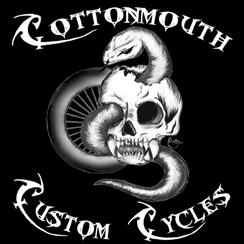ALABAMA coasting presents

HOW MUSIC TURNS DARK INTO LIGHT
Announcing our new music therapy program: AHERO Records
Page 10
WINTER 2024






ALABAMA coasting presents

HOW MUSIC TURNS DARK INTO LIGHT
Announcing our new music therapy program: AHERO Records
Page 10





I want to take this moment to express my deepest appreciation for the unwavering support you have shown to our AHERO organization. Without your steadfast dedication and commitment, none of the incredible achievements we have made would have been possible.
Today, I am particularly excited to share some wonderful news with you all. Thanks to the efforts of retired USMC Colonel Mike Corrado, our great friend and director of AHERO Records, we have established the AHERO Records (AR) studio! This new milestone is a testament to Mike's exceptional talent and experience as both a musician and a leader.
The AR studio will inevitably become a hub of activity as a place of creativity and healing for our Veterans and First Responders. Here they will find the opportunity to express themselves artistically and find solace in the power of music. Please see Mike’s amazing team at AHERORecords.com and share with friends and family.
Speaking of opportunities, I am thrilled to announce that we have yet another one opening on the horizon. Retired Navy Captain Dave Oden and his wife, retired Navy Commander and Doctor of Acupuncture and Chinese Medicine Rachel Oden, who is also
a certified clinical specialist in orthopedic physical therapy, have opened the way for us to establish an AHERO program near Bozeman, Montana.
With their combined passion for and dedication to supporting our heroes, this husband and wife team has already opened doors to a brighter future for many in need. We at AHERO are grateful for their vision in recognizing the potential this program holds for positively impacting the lives of even more deserving warriors.
These accomplishments would not have been possible without the unwavering support of our sponsors, partners, volunteers, and amazing AHERO community at large. Which is you. Your generosity, commitment, and love have been the driving force behind our success.
I’ve said it often, because it absolutely bears repeating: We are humbled by your belief in our mission and your selfless contributions that make it possible to carry that mission out.
Together, we are making a meaningful difference in the individual lives of those who have sacrificed so much for our safety and freedom. As we move forward toward another new year, we gratefully ask for your continued support.
Montana has now heard our name as have a few other far-reaching areas of this country. This is because, even though we don’t have a public-relations network blanketing the 50 states with our message, we do have the good will of many generous people who believe in AHERO and remember to spread the word.
That’s you. You have never let us down.
Please help us grow our outreach now by also sharing the story of AHERO and its mission with your friends, families, colleagues at work, and folks wherever you worship. Encourage them to join our cause so that we can help the growing number of worthy Veterans and First Responders in need of the kind of attention and affirming love AHERO offers.
Once again, we thank you from the bottom of our hearts. Your compassionate dedication is what allows us to make amazing things happen that honor and lift the spirits of our wounded and injured Veterans and First Responders.
God Bless and Semper Fidelis!
Lee Stuckey Founder & President AHEROusa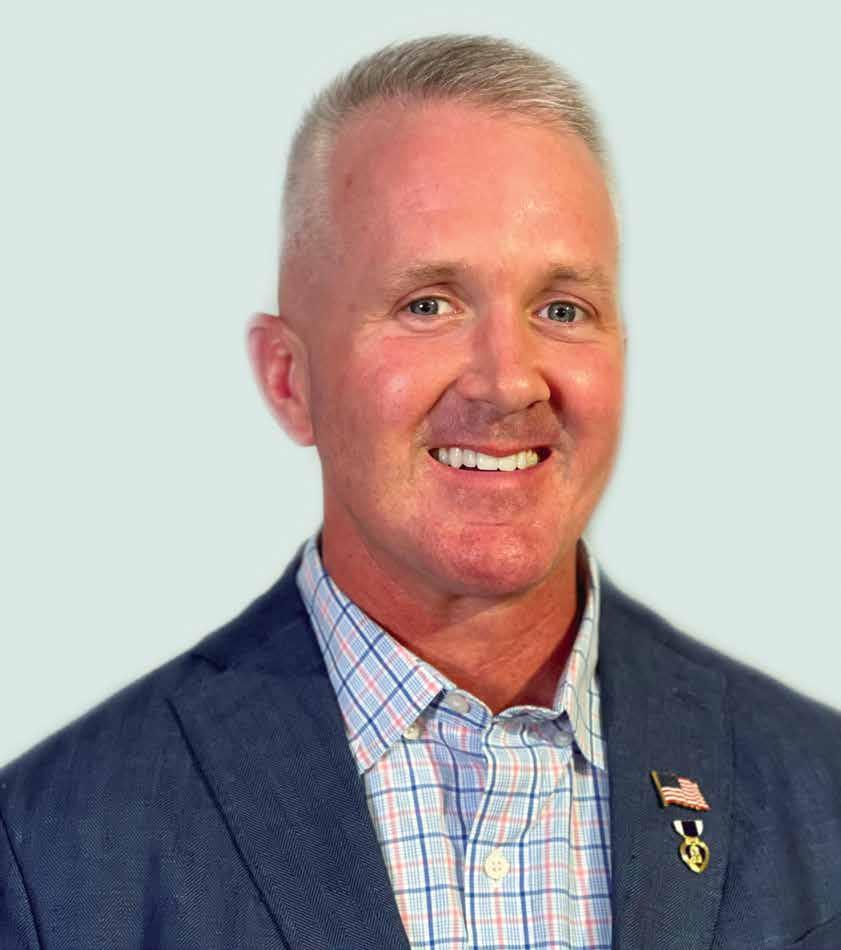
Reports of Military and Veteran suicide* statistics vary widely. The figure quoted can range from 20 to 30 per day when even one is too many. The number most often given for these great losses, however, is 22.
The mission of AHERO is to reverse the upward trajectory of this statistic – and to do that by recognizing and uplifting those who are most at-risk of adding themselves to it. They are the men and women whose military-service injuries to body, spirit, and soul have made them more likely to take their own lives.
AHERO works toward this goal by introducing them to programs and resources that can increase their overall quality of life. These include:
• Developing an informal support network of Veterans across the country.
• Encouraging constructive communication and engagement.
• Boosting Veteran morale with shared outdoor activities and meaningful gatherings.
• Drawing on our interconnected organizations that provide additional important holistic pathways to healing and wellness.
AHERO will accomplish this by welcoming Veterans into communities willing to donate the time, recreational equipment and the natural and financial resources necessary to support events that facilitate fellowship, communication, and mentoring. Through these activities, AHERO will establish and support a network of Veterans with personal experience in learning to deal with the emotional and physical wounds caused by the stress of service and combat. The network will be self-sustaining and support Veterans across the United States of America.
On September 11, 2001, our courageous First Responders rose to be the first line of defense against a focused terrorist attack on our nation. Since then, the country has seen numerous occasions of bravery and self-sacrifice by the dedicated men and women who fight our fires, protect our lives, and provide us with emergency medical treatment and transport. AHERO therefore counts America’s First Responders among those uniformed service members (many of whom are military Veterans in their own right) and Veterans we serve.
AHEROusa is a 100 percent volunteer-run, 501(c)(3) charitable organization. More than 95 percent of all donations received go directly toward benefitting the Veterans and First Responders we serve.

Life has an uncanny way of surprising us with unexpected paths and opportunities. My own journey was one of self-discovery, having taken an unforeseen turn when circumstances led me to pursue a bachelor’s degree in science in America.
Born in Jerusalem, Israel, with family in many countries, I elected to skip the opportunity I had for higher education and instead embarked on a fulfilling career of a total of 10 years in the German Armed Forces. I then accepted a post of serving three years as a foreign liaison under the United States Army Training and Doctrine Command.
But my life took an even more remarkable twist when I retired in the United States. I had been drawn to Alabama by the love of my life and now husband, Lee J. Stuckey, a retired US Marine Corps major and founder of America's Heroes Enjoying Recreation Outdoors (AHERO).
I always like to express my gratitude for the German and American military's support in covering a portion of my university expenses. The challenge of pursuing a degree as someone older than my student peers whose native language and background differed greatly from theirs contributed to the transformation I would undergo as a student.
I grew up a city girl who never anticipated she would be called “the German Redneck,” as my husband now nicknames me. My military service brought me to the United States, where love and very profound new life interests awaited me. I’ll always be grateful for my experiences and growth as a member of the German military and the unique support I was afforded as a foreign solider on US soil. I believe, though, that the contrast in transitioning to civilian life was more pronounced for me than for most military persons who do this in their own country.


The stark cultural differences between Germans, who tend to be more stoic, and people who have grown up in the vibrant atmosphere of the American South created real complexity in my daily life and social interactions. Nevertheless, I wholeheartedly embraced these challenges with determination. And, of course, with my German resilience.
I resolved to keep my purpose always at the forefront: It's not about me, but rather what I can do for others, and how I can leave this world in a better state than I found it.
My chosen field of study, wildlife enterprise management, reflects that purpose: It is my commitment to society and the environment we are living in. And, I hope, it has the potential to empower me to help AHERO, a charitable organization dedicated to preventing suicide through outdoor recreational activities. These include fishing and hunting in coordination with the principles of preservation and wildlands management.
This organization’s brand reflects its methodology of bringing people together. Its recently acquired MajGen James A. Livingston AHERO Warrior Lodge mirrors this, providing us with the facility to accommodate numerous wounded or injured active-service and military Veterans, First Responders, and their families, in a comfortably designed, homelike environment.
A family is a tight-knit entity. If one part is disrupted, the whole unit may struggle to function properly. Recognizing the power
and significance of this, we at AHERO aim to ensure each participant experiences solace, camaraderie and a renewed sense of purpose here, in an environment as stress-free as can be.
The knowledge and skills I have gained over the years have helped to prepare me to pursue my own aspirations, which align with AHERO’s mission. As a sanctuary for those who have suffered through serving this great nation, the Lodge will provide a place of safety and relaxation. Here, recreational activities, training, and connection to other Veterans service organizations will be provided. With the benefit of my military background and course of education, I feel well equipped to help manage the Lodge, ensuring the best healing environment we can for the heroes we serve.

Writer Ken Perrotte’s story is on Mike Corrado, director of AHERO’s newest music-for-and-by-Veterans focus, AHERO Records. Perrotte’s full story was published this year in USA Today’s Special Memorial Day edition, Saluting Our Vets. AHERO Magazine gratefully received USA Today’s permission to publish the article, “Giving Voice to Vets,” with restrictions. We are delighted to offer an excerpted version here. ~ the editors

A recording label focused on helping active-duty military members, veterans and first responders create and distribute music launched this spring in Tennessee.
AHERO Records was formed as an offshoot of the nonprofit America’s Heroes Enjoying Recreation Outdoors (AHERO). Retired Marine Corps Col Mike Corrado is the label’s director.

A longtime musician and recording artist, Corrado’s vision is for the label to be a vehicle for artists needing to be heard. AHERO wants to help grow their audience, provide touring support and performance opportunities and seek placements in television and film projects.
The label’s first release was issued at the end of March. The song My Legacy
was co-written by Corrado, Kevin Adair, Jeff Silvey and Rusty Tabor and inspired by Mike Miller, a combat-wounded Operation Iraqi Freedom Marine Corps veteran.
Several years after separating from the Marines, Miller was working construction and fell from a 20-foot scaffold. He broke his back and several other bones. “X-rays

and other imagery from the fall led to the discovery of a tumor he had near his brain,” Corrado says. “As he continues to battle brain cancer, we were able to sit with him and write his story.” AHERO staff writer Tabor sings the song.
AHERO Records is based in Shelbyville, Tenn., about 60 miles south of music vortex Nashville. “As an indie label, we plan to start small, with a handful of artists we can develop and focus on,” Corrado says. “We have a small staff and are primarily focused on bands and singer-songwriters who are out playing live.”
For artists early in their careers, AHERO Records plans to host songwriter retreats “where we can help them create something marketable. We will have recording facilities, a lodging and dining area and a small live music venue.” As the label matures, the aim is to gear support specifically to the needs and experience of individual artists.
A key element in AHERO Records’ mission is protecting its artists from the vagaries of the music business, known for sharp deals and harsh tactics, and to ensure they “feel the camaraderie of service and have a team to engage the downside of the music industry by securing deals for the artist, not the label,” Corrado says. It has also established AHERO Music Publishing.
Tim Murray, a staff sergeant in the reserves, is a singer-songwriter living in New Jersey. He began playing guitar at age 14 and writing music shortly after enlisting in the Marines Corps.
“It was kind of an outlet,” Murray says. “The older I got, the more I tried to make the music as real as it could be. I want to write music about things I have a connection to.” Murray says his music blends country, Americana and folk. The late singer-songwriter John Prine was a major influence. He has two self-recorded songs on Spotify and is excited about laying down more professional tracks.
AHERO Records, Murray says, has “been helping me get some raw stuff down and recorded. They’re developing me, helping me take my songs to a new level. They have such a wealth of knowledge and experience.”


“As a songwriter and musician, you really don’t know who you can trust. With AHERO being military [veteran] operated, there’s a sense of trust. And they understand how to work around the schedules of people who are on active duty, moving and deploying.
“Five years ago, music was something I did in my spare time,” Murray says. “They’re helping make it more of a reality, something I can share with the world.”
When he accepted the position with the label earlier this year, Corrado posted a transition video on social media. “I took off my Marine Corps cammies, put on an AHERO hat and announced the opening of AHERO Records,” he says. “Within a few days, we had some 100,000 views and were contacted by over 30 different military, veteran and firstresponder artists.”
Previously, Corrado says, the label had been targeting artists he knew or followed –“people we thought we could help. Now … the artist aperture widens exponentially. I wasn’t surprised. I know the talent is out there. I’ve seen it in barracks, on ships, on deployments, in combat zones and in our communities.”
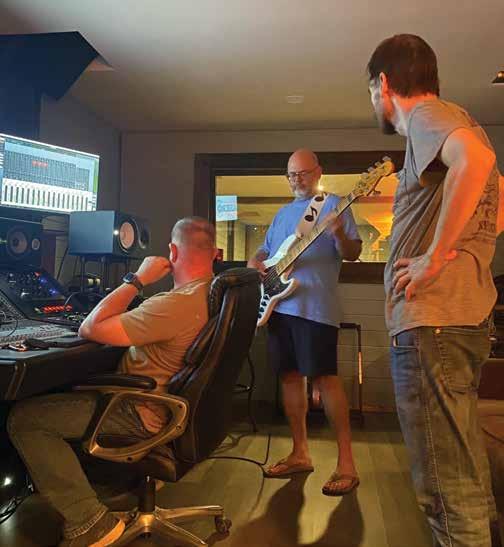

“As a label, the first thing we want audiences to find is incredible music,” Corrado says. “The second thing is an incredible story about the artists.” He mentions several noted country performers who are also veterans, and says the company wants “to bring you the next Sturgill (Simpson), Zach (Bryan) and Jamey (Johnson).”
A photo accompanying Corrado’s profile on the AHERO Records’ website profile bears the inscription, “Breakup songs for men and their inner demons.” He says the phrase was coined by representatives at Taylor Guitars when he was featured in the company’s national campaign focused on the different ways artists use music. It sounds weighty, and many of the songs associated with veterans do deal with serious, difficult issues.


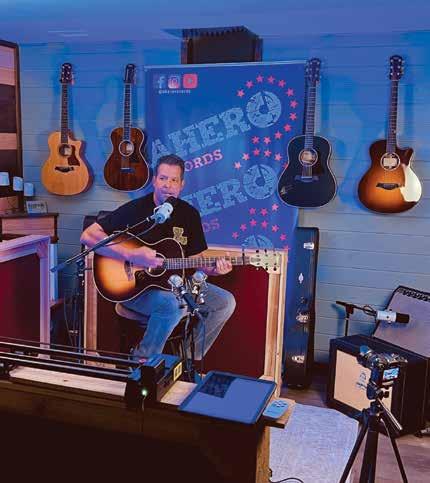
“When people hear of a military artist, sometimes the first thing they assume is their songs are probably all about the military or patriotic in nature,” Corrado says. “Those songs are great and a way for artists to express themselves, but we want more than that. We don’t want our artists being pigeonholed in the patriotic music category.”
In his own case, Corrado says, “it was advocating the music and message to raise awareness of post-traumatic stress disorder, traumatic brain injury, depression and suicide.”
Like its parent organization, AHERO Records relies on donations to operate.
According to Corrado, all of the work invested through spring 2023 has been pro bono. The hope is that funding streams will eventually enable the label to become self-sufficient and grow the staff. “For now, we are keeping things as inhouse as possible,” he says. “This helps keep costs down for us and our artists. I guess you could say we’ve adopted the Marine mentality of ‘Do more with less.’”
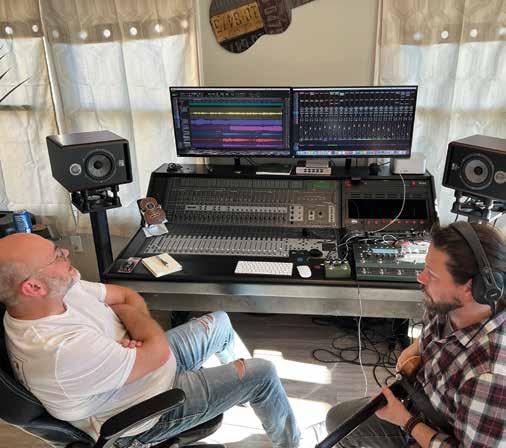


Dave Bray is a former Navy corpsman. A medic: Meaning, he served as the dude traveling with a particular group of Marines or Special Forces guys administering medical aid as needed. Plunging into the fire with them, looking out for them throughout the mission.
But now, when you watch Bray-theperformer rocking out his anthems, it’s hard to see the corpsman. You just see Bray heading into the fray.
He doesn’t hang quietly on the sidelines. He jumps in – full bore, full volume, getting it all out so nothing’s left unsaid when he has finished his performance.
Back in June 2021, when Dave Glassman and I were planning the first Freedom Quest event, we considered numerous bands as headliners for the 20th year of honoring the fallen of 9/11. Wanting a band with passion and pathos, we sought one whose music evoked the wonder and promise of the UNITED States … not partisanship.
We considered many talented acts but decided on Dave Bray USA. Problem was, he wasn’t available. He’s a very popular guy. Which meant, we couldn’t afford him anyway.
Two small hurdles!
So we hatched a sneaky plan: Could we get permission from Dave Bray’s manager (happens that’s his wife, Becky) to screen his songs and videos on the huge jumbo screen provided by our Freedom Quest founder along with the master event-stager of many decades, Pez Marrier?
“Yes,” was the quick answer. So Bray went on to fairly command the stage at our event …. even though he wasn’t technically on a stage.
People placed their hands on their hearts during his rousing rendition of the Star Spangled Banner. Some wept. And even though Bray’s performance was coming to us transmitted live all the way from York, Pennsylvania, he “rocked it out of the park” as we all joined in singing America’s national anthem.


To be honest, for our first 9/11 event, which was held in Sandestin, Fla., we had kinda messed up. We hadn’t raised enough money; we didn’t plan the event well enough; and it rained. So only about four people showed up. OK, more than four. Maybe 40.
Nevertheless, Dave sang his heart out for us.
And, as he started his final set, he did something rather wonderful. Something that cemented his integrity in our hearts: He initiated his amazing presence as (we hope!) a mainstay star for Freedom Quest.
Thing is, Dave Bray USA is quite a big deal. He and Becky are in serious demand all around the country. Pretty much every weekend, Dave can be found attending sizable military or first responder events of note. He has pumped out his patriotic anthems to tens of thousands on the National Mall – has even played for our presidents on numerous occasions.
So one could expect some prima donna behavior.
But as darkness descended on that rainsoaked, sparsely attended, September 2022 evening in Sandestin, Bray stepped down from the stage and invited all the assembled to draw near.
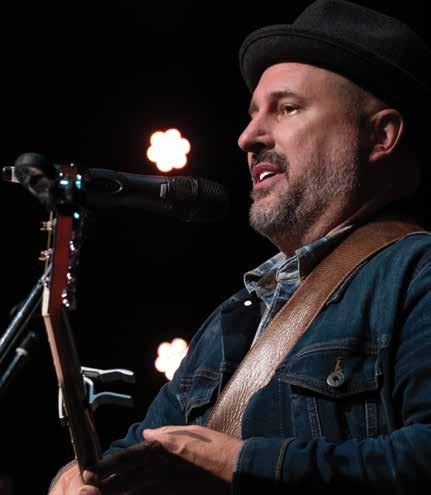
He began to sing, opening his arms to invite everyone closer. They started to sing, as well. And loud. Their faces beaming, their smiles wide, they thundered out the lyrics.
It wasn’t a “red” crowd or a “blue” one. It was just a modest mix of residents, tourists and passersby ranging from the elderly to middleaged and young adults, to kids. Basically a group of Americans feeling patriotic.
And it was Dave Bray who brought us all together, “indivisible” again, last September. Came to do it this time in person in Sandestin. It was Bray who filled our hearts with his “loud and proud” self when it comes to this country that we all love. And he did it until there was not a dry eye in the bunch.
So from us to Dave: We thank you, sir!
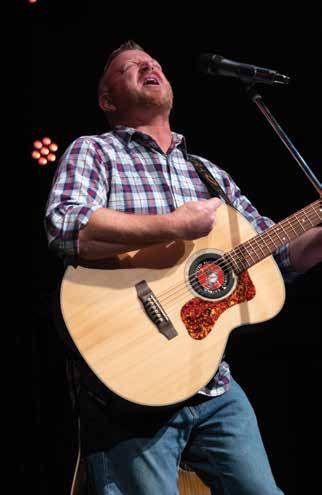



There’s a story behind every song that has the power to touch the listener’s heart. Whether it describes why the song was written or explains the thought behind the music’s unique chord changes, there’s always a tale to be told. So when well-known singer/songwriter Rusty Tabor sat down with Fire Chief Jonathan Kanzigg to follow Bob Regan’s Operation Song model of healing through collaborative songwriting, this is the story of the hauntingly beautiful song that emerged.
I arrived at Marcus Pointe Baptist Church in Pensacola Beach, FL at 7:45am, May 20th, 2023. After a couple too many doughnuts and while swigging our bottomless supply of coffee (thank you G-Man!), I sat down in a private Sunday School classroom with Fire Chief Jonathon Kanzigg, of Gulf Breeze.
We had planned this gathering over the months before as part of the Freedom Quest/ AHERO event held at the Rex Theater that very evening. This morning, though, was mostly typical for a Veteran/First Responder music therapy session.
Those of us participating in this program session were met with smiling faces, each conveying a bit of friendly curiosity, and there were welcoming words seemingly on every tongue. Following these pleasantries and per the established writing schedule, we paired off, each musician with someone whose wounded soul needed to express itself in a song. Together as a team, we went to our respective rooms to begin our journey into hurting, hearing, and healing.
I tuned my guitar and retrieved my trusty spiral notebook while Chief Kanzigg and I chatted, solving the proverbial woes of the world and laughing at funny things that had happened earlier in the morning. In other words, just loosening up.
About now, I should tell you that every single songwriting session with a Vet or First Responder is unique in its own way. A lot of participants aren't as forthcoming with their memories or stories as they imagined they would be. But I knew we needed to start, so once my guitar was tuned, my pen at the ready and a pause in the small talk holding, I looked over at the chief.
I said, "Tell me about being you."
I rested my faithful Gibson acoustic on the chair nearest me. My attention was now tuned to Chief Kanzigg, and as he spoke, I began taking notes.
I am not, and have never claimed to be, a therapist or healthcare professional of any kind. I am a songwriter. However, having done this sort of collaborative project for well over a decade with folks who have been through hell, I feel confident in my ability to assess when someone truly needs to talk. Which seemed true of the chief.
As a 19-year-old joining the local fire and EMS department, “I was very gung-ho, feeling full of pride and courage and as if I were bulletproof,” he said. “I considered my team to be heroes with a calling and figured we could do anything. Then I had my first tragic experience.”
This was when he was still nineteen. Right away, he had my attention as he told about performing CPR on a child.
“That was Zack,” he said, speaking the child’s name almost reverently. “He didn’t survive.”
(Out of respect for the family’s loss, only his first name is provided here.)
He was just starting his career at that point, but Kanzigg would soon learn that such highpressure incidents were not going to be rare. He began to realize the seriousness of the commitment and the level of responsibility he had taken on. Since then, the endless reminders of the job’s always-imminent dangers have followed him constantly.
“They changed me,” he said.
I was scribbling away, taking notes. Time ticked along as the chief spoke of other experiences, some less dangerous but still threatening, and some actually funny or innocuous and annoying.
This sort of intense conversation is exactly what is needed when two people collaborate to create a song such as the one we were attempting to write here. It also is emotionally taxing, so we needed to re-energize. Taking a break, we went out for a delicious Subway sub and another cup of Columbia's finest; then made our way back to finish our session.
We settled back. And took a pause – me with no idea about what was about to come.
The chief began speaking again, but differently somehow. His usually easy-going delivery was now stoic but also revealing. He grasped his hands together as if to wring them, though he didn’t, and he shifted then straightened in his chair. I sensed the gravity of what I was about to hear and prepared to focus on his underlying emotion as he told the story.
"It was almost summer – June 9, 2018, to be exact. We got this call. A house fire had broken out at an area residence in a nearby gated community." He looked at me, and then the story poured out.
There had been several people at the house as the fire started, and the chief, with crew in tow, rushed to the location. They arrived at the community entrance in a matter of a couple minutes, but the mechanical gate was closed. He recalled the feeling of helplessness as he could see the smoke from outside the gate as they worked to get in. But in the course of the 13 minutes it took to get on site, the fire had become a blaze and parts of the structure had fallen or become impassable.
The fire crew struggled to get information in the chaos then learned that everyone had gotten out of the house – all except one beautiful young person. A teenage girl had been in the shower when the fire broke out.
Fire Chief Kanzigg reveals outof-character nervousness as he describes for the audience his emotional response to living through all that led up to writing the lyrics to "I Was Leaving You," with Rusty.

“We couldn’t get to her,” the chief said. “There was just no way. No matter what we did, the crew and I couldn’t get in there in time to save her.”
Eventually, the smoke cleared, and the scorched debris was hauled off. All the fire company’s equipment was cleaned up and returned to its rightful place ready for the next emergency, but the true damage of that fire – which could never be set right – had been done.
And nothing in the five years intervening had dimmed a moment of the chief’s memory of furious frustration as they battled to save that young girl.
Chief Kanzigg went on to tell me how, not long after this particular fire, he packed some things into a bag and quietly left his house. He was, he said, tapping out. Leaving. He didn't know where he was going or what he'd do when he got there, but he was going. This man who had saved countless lives, consoled grieving family members and given his life to his community for the greater good had come to a place where he felt his own family was better off without him.
Convinced that he was a great disappointment and having gone through all of the steps available to him for support, he felt unworthy. He'd decided there was no reason why he should stay or even exist. He had failed when it really mattered – or so it seemed to him as he left home.
On his way out of town, the chief decided to stop at a little secluded spot on the beach that he'd gone to for years when he needed some "alone time." It would be a good, deserted place to say goodbye to the life he'd known and loved but that now seemed to weigh too heavy on him. “But just as I got there,” he explained, “I saw an older gentleman was sitting in my exact spot, looking out over the water. Then he turned and saw me.”
The two strangers started to talk. The kind-faced, elderly man listened as the chief spoke haltingly about what happened, maybe revealing more of his hopelessness than he meant to.
“Then this fella looked at me and said something quietly that kind of stopped me,” Kanzigg told me. “I really can’t even tell you what it was. I’d never seen anyone else here in all the years I’d come, it was my secret. But there he was on that day, and something about him and whatever he said somehow changed my thinking.”

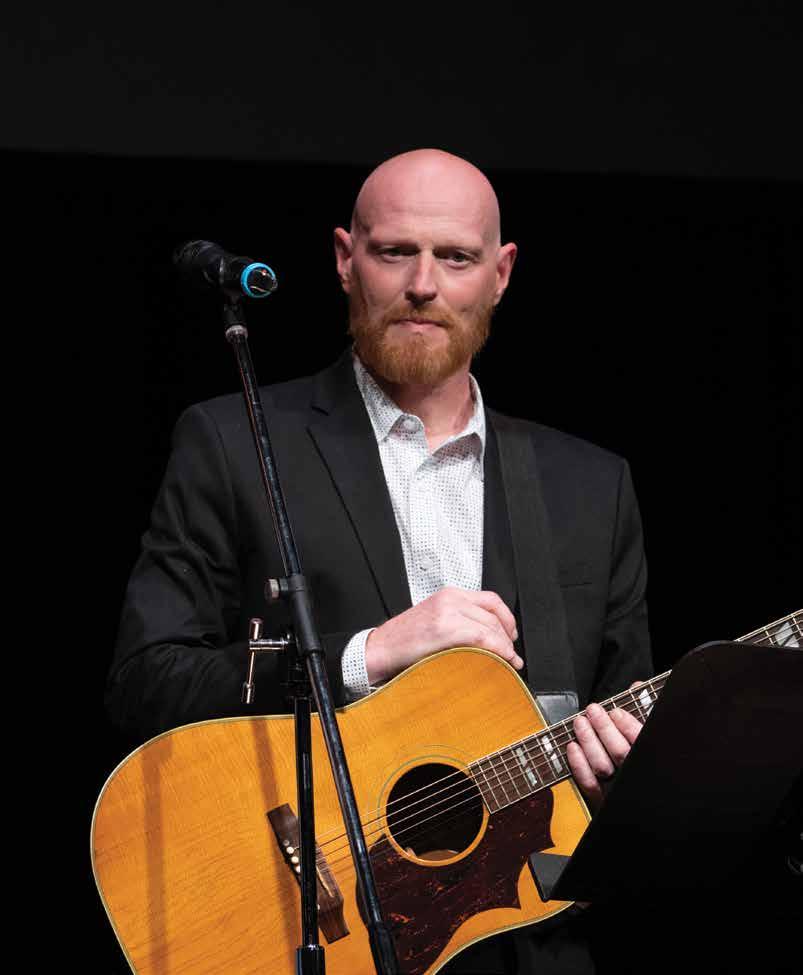
A feeling had come over the chief at that point. He couldn't explain it, but for whatever reason, he simply turned and went home.
It was here that I stopped him and asked, "Do you believe in Angels?"
EVERYDAY HEROES
Life is the most precious gift any of us will ever receive. So I’d venture to say that the men and women whose career paths mean they must live with death and tragedy more than most of us ever would want to do deserve a certain kind of respect and consideration. The scenes replaying in their heads on a daily basis are often horrific, yet they are part of what’s entailed in doing a job only persons as rare as they are willing to step up to do.
Their business is saving lives and they are extremely good at it. The unfortunate side of the lifesaving business is there will be casualties. For most, if not all, of the first responders I've had the pleasure of getting to sit down with, these casualties overshadow the saves. But even more challenging than the physical, mental, and emotional challenges for these heroes is the balancing act of work and family life. Being strong for their own families even while witnessing all they see while on duty seems to be their biggest struggle.
I recognize that Chief Kanzigg's story isn't an entirely unusual one for anyone in the field of emergency response. My hope is that everyone reading this or hearing the song we ultimately put together will try to understand the rigors of this life: the mental fatigue and emotional repercussions its practitioners suffer, the physical toll it takes on them. All of these amount to a sacrifice few among us would be willing to make, regardless of the honorable term “hero” we would earn as a result.

Climbed onto the truck when I was 19
Jumped straight into the fire, I was living my dream
We were heroes with hoses, me and my team
I’ll always remember the sound of the ring
When that call came in and changed everything I couldn’t get my mind to forget what my eyes had seen
So I was leaving you – but you didn’t know it
I felt guilt and shame and hurt – but I didn’t show it
When I put on that uniform, I thought I knew what I was put here for
But they don’t tell you how you’re supposed to get through
So I was leaving you
Took 13 minutes to get to the house
The flames had taken over, she had no way out
And we had no way in, now I have to live with the pain and the doubt
So I was leaving you – but you didn’t know it
I felt guilt and shame and hurt – but I didn’t show it
When I put on that uniform, I thought I knew what I was put here for
But they don’t tell you how you’re supposed to get through
So I was leaving you
Thank God for plans that don’t come true ‘Cause I was leaving you
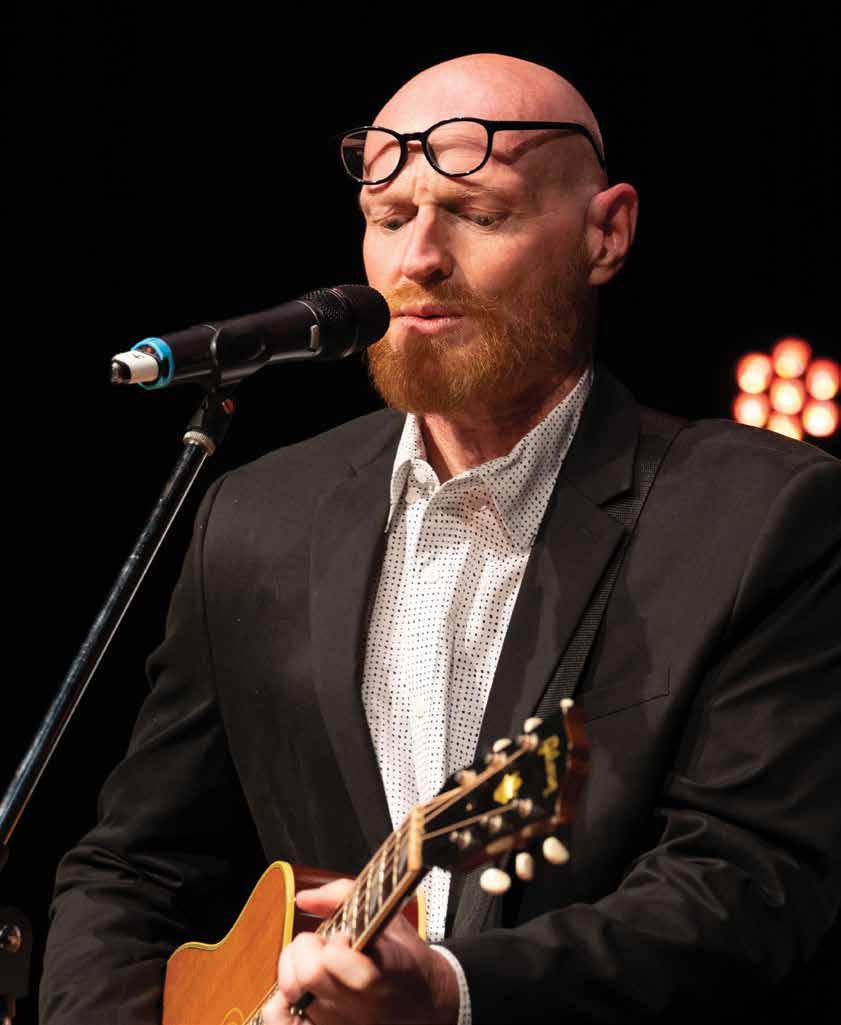

Muscogee Chief Ghost Dancer graciously demonstrated his tribe’s distinctive dance for the Freedom Quest audience.
The chief described his great pride and delight in representing “traditional ways through beauty and love in music, dance, and culture,” and he spoke of “one people walking together in peace and love.”
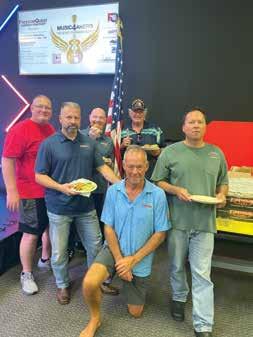






Listening to Muskogee Chief Ghost Dancer, Freedom Quest participants learn more about the music and traditions of his Muscogee Tribe.
For years, we’ve gotten a “presents on Christmas morning” feeling when thousands of copies of the most recent AHERO Magazine issue arrive on pallets. We can’t wait to settle in to read one, excited and proud of the latest gloriously designed and printed, sometimes 100-plus-page culmination of the work of our staff and other generous contributing writers.
And even after months of monumental efforts made by all, it still seems like each
edition just appears as if by magic.
In our most recent issue, we carried a story on the opening of the AHERO Lodge, in Tuskegee, Alabama. We described the huge, exquisite kitchen island that graces the true heart of the Lodge, and around which thirty or so people can commune.
Yeah, really. Thirty.
But as we pored over this herculean thing, it wasn’t the size that impressed; it’s how it was just so darn fine. You could tell by the intricacy of its practically invisible joints. The whole thing (visualize its size – 25 ft x 15 ft!) looked like it was carved from a single solid block. The drawers fit so snugly you couldn’t slide a piece of paper in. They opened and closed with the kind of damping you’d expect to find from … oh, maybe a carpenter trained by Rolls Royce?

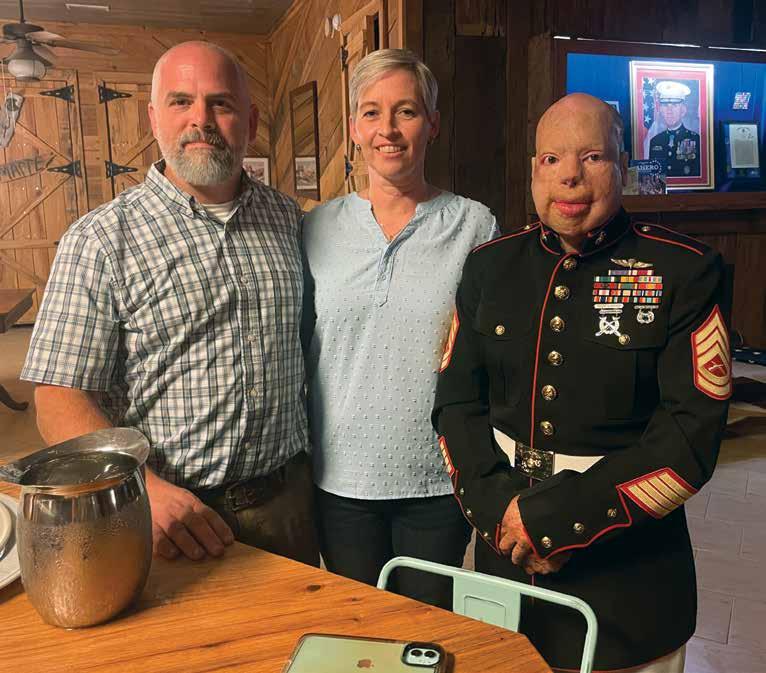
This beautiful cabinet took the breath away from everyone. Leaning in for a closer look, one gent muttered, “How the heck did he do that?” about this astonishing piece of craftmanship that perfectly symbolizes the ethos of AHERO, which is connection.
The cabinet was built by one Jimmy Starling. Looking at it, you’re thinking “That had to have taken frikkin’ months to make.” Yet this craftsman is so humble, he made sure to leave before other folks arrived at the new Lodge and, upon checking out the kitchen, immediately admired “that gorgeous center island!” in wonder.
I suspect Jimmy was back in his workshop by then, creating something new, with this beautiful piece only a distant memory.
THE METAPHOR HOLDS
The “brief” on what was needed was given beforehand by the lovely lady of the Lodge, Tamar Doull (now Mrs. Stuckey). She outlined her design of the island to fit the desired footprint she’d marked out on the floor with duct tape. She conveyed her idea, and Mr. Starling fully understood the task: Make it magnetic; let it draw people. For this was the heart of the Lodge and where links, connections, would be – and now are – forged.
So what, you may be wondering, is the link between the glorious center island of the new AHERO Lodge and the glorious magazine I began this story by describing?

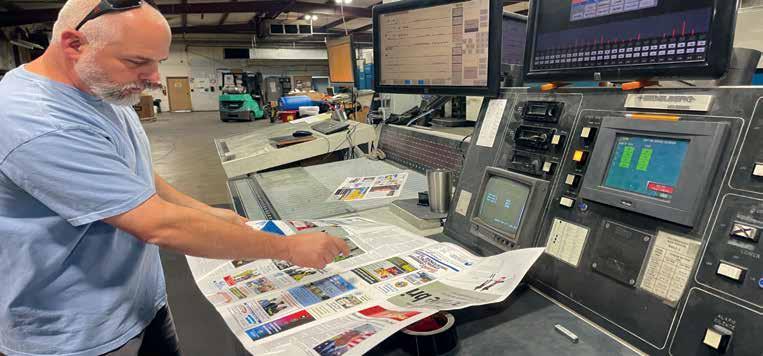

Listen up: As it happens, the Starlings (Jimmy, his wife, Jennifer, and his two brothers, Harvey and Robbie Starling) run their wonderful printing company, Publication Plus, which has been printing this magazine since its very first issue. This has always been done in coordination with our great friends and constant supporters, brothers Danny and David Calametti, owners of Alabama Coasting, our publisher.
In a long overdue effort to learn more about the Starlings and their printing operation, AHERO VP Dave Glassman (our editor in chief) and I decided to get eyes on the Starling operation to see how they roll out this publication you now hold in your hands. How they keep it looking as glossy, classy, and colorful as Alabama Coasting’s graphic designer, Randy Jennings, designs it.
We approach the offices of Publications Plus, outside of Montgomery, Ala., set in a lightengineering commercial business park of the usual business-park sort.
Until you get inside and see the printing press.
First clue: That press is impressively huge. German-made, it’s a “Heidelberg,” so when I say “big,” you should maybe think roughly equal to the width of a football field.
You tracking?
The Heidelberg in operation means business. It prints at a higher quality than any digital printer can yet attain and it likely will do so for the maybe another decade at least. So when Glassman and I are shown examples of the Heidelberg’s printing, we take note.
Because the print is pin sharp. Which we already knew – witness every issue of AHERO Magazine. Starling then explains why it will not be eclipsed by digital printers any time soon: A digital printer-head “follows” the paper, he says, moving at speed a few millimeters above the paper as it sprays (in a very old-school, highly effective process) ink onto the paper. Does it four times: with CMYK – the Cyan, Magenta, Yellow and Key (black) inks we all know and love.
You can’t match any of this – Starling cabinetry, carpentry, and Starling printing that no machine without the eye and heart of analog engineering artistry seems as yet able to achieve.
After our tour of the printing press, we sat down with Jimmy Starling. Glassman, ever alert to the humanity within the person he’s listening to, proceeded to gently elicit details of Jimmy's own story, and something about his motivation.
All of which might be the subject of a future article on these Starling-printed pages. Suffice it now to say, this is someone we think of as a member of our AHERO tribe. We’re incredibly grateful for his talent, his experience, his commitment, and his spirit. And that of his lady wife, who is surely the printer’s Princess. Altogether a Superstar couple, from a Superstar family.
We thank all those Starlings from the bottom of our AHERO hearts!

“Throughout the time we were acquiring the Lodge and doing our renovations, we attended Wednesday night Bible study at our local church. We always have a Southern potluck followed by Bible study lead by none other than Jimmy Starling. His entire family attends to hear him lead the discussion. Jimmy, a master carpenter, knew of our mission at AHERO and asked to be the person to custom build a kitchen island for us, a gift. It turned out to be the hugely impressive piece Jeremy Clarke describes in his story here. But we never knew about his Starling family’s printing role in our magazine (printing is done through our publisher) until Jimmy started helping his brothers. They were around when there was a significant error in the latest edition. It wasn’t a printing error, but nevertheless the Starlings stepped up to help in a big way.
This all started with a Wednesday night Southern Baptist tradition and turned into yet another ‘Community Supporting AHERO’ blessing. There is no such thing as coincidence; it is always God. My life has shown this time and time again.”
~ Lee Stuckey


In the heart of Shorter, Alabama, a remarkable nonprofit organization is making a significant impact on the community. Called “Venison Provisions,” the group is led by Shana Howard, longtime AHERO supporter and owner of Shana's Place, a shop offering delicious, prepared foods as well as wild game and retail meat-processing services.
As the name suggests, Venison Provisions receives donated, legally harvested deer and feral hogs and provides the meat from these, professionally processed, to Alabama families facing the crises of food insecurity.
These meats are delivered by Shana, her staff and volunteers to points throughout the state. The organization’s mission is not only to provide nourishing foods at no cost to residents in need, but also to ensure that none of the harvested wild game animals go to waste. Hunting has been a common activity and, for many, a family tradition throughout our country’s history. When done in lawful areas following rules ensuring safety and herd


sustainability, it is also a vital part of managing the health of our cultivated and wild lands.
Animals are sometimes harvested by hunters, farmers and trappers who do not take the carcass to be butchered but instead leave it to rot in the field. Recognizing the problem, Shana Howard saw a great solution: Why not bridge the gap between surplus harvested animals and families in need? Venison Provisions became that solution.
Shana and her staff and volunteers work tirelessly to make sure the unwanted deer and hogs are collected from trappers, hunters, hunting clubs, farms and other Alabama sources. The animals are brought to Shana’s Place to undergo a meticulous processing procedure that transforms them into highquality protein, as nutrient-packed grinds and cuts for delicious, healthful meals.
These burger, cubed steak, backstrap and sausage meats are now being delivered to many ministries across Alabama. Foster and adoptive homes, orphanages, Christian addictionrecovery homes, maternity homes, teen and women’s centers, and small community food pantries – all are considered the “mission field” where the meat donated by the organization is distributed.
The potential for an organization like Venison Provisions to have a positive impact on communities cannot be overstated. It is evident right here in Alabama. Families who too often struggle to put healthful food on the table can check local distribution centers for their meat and other food needs.
Ironically as of now, no permanently established food banks or pantries are available in Shana’s own home county of Macon. Her answer? Develop an inhouse system of directly providing Venison Provisions meat and other foods to families in her area who are in need. So this is what she is doing!
Land managers and farmers in her area who are faced with controlling the feral hogs and deer herds on their land have a place that will accept and butcher, at no cost, the animals they harvest. They can rest assured knowing that those they remove will be a blessing to the less fortunate of Alabama. This mutually beneficial arrangement can have a ripple effect, fostering a sense of community and compassion in those involved. Under the inspiring leadership of
Provisions and the ripple effect it creates will continue to grow, drawing the support of hunters, donors, staff and volunteers, throughout Alabama.
As word spreads, we believe awareness will also grow of how “nature’s bounty” sometimes goes to waste, and how it can
instead be saved as a valuable resource for the less fortunate among us. The brilliance of Venison Provisions is that it has the potential to become a nationwide movement that not only tackles food insecurity but also promotes responsible hunting, trapping, depredation and overabundant-resource utilization.


Learn more about this important, not-for-profit service by visiting Venizon Provisions online soon! www.VenizonProvisions.org

SORRY, MR. VULTURE – NO TASTY SCRAPS HERE FOR YOU TODAY!
AHERO, like so many nonprofits, is in existence because of the big hearts and open wallets of people like you who are, at this moment, reading this magazine. Still, the truth is that there are many Veterans organizations out there, so maybe it’s too much work to decide where to give your donor dollars. Also, frankly, it’s annoying to have to figure out if your hard-earned cash is helping the actual cause or just funding a few mighty big salaries.
We take our responsibility to the donors and supporters immensely seriously. And we want you to know how the money actually gets spent. Meaning how we operate, as distinct from how so many other non-profit Veterans Service Organizations and First Responder support groups do. It’s sort of our secret sauce. Except it’s not really “secret” at all. We’d love it if other organizations stole our method and used it. Because it works!
Since in physics (or mathematics, or whatever) a thing is the sum of its parts, let’s break this AHERO secret-sauce thing down:
PART 1:
We let it be known that we want the family and friends of Vets and First Responders to be aware that we are here, we are accountable, we don’t charge for our services, and we are capable of helping their wounded/injured, disabled or struggling loved ones back to being open to life.
Meaning remembering some of the good dreams and experiences they had before the world just piled in on them.
We know how that “piling on” can happen at any time. Some call it “despair,” and it destroys. Relationships, ambitions, hopes are all under attack and often fall by the wayside. But we also know that building a bulwark against despair can start with interacting with fellow travelers who have known that dark path you’ve followed or are still on but are learning to light with hope.
Peers you can meet and talk to … who you can see are holding up okay. Which is why we call AHERO the “Landing Zone,” or LZ … the port of call for weathering your storm.
PART 2:
Having set itself up as such, AHERO is duty bound to help. We invite them down to our new Lodge in Alabama or the Gulf Coast to hunt, fish, dive, off-road, engage in teambuilding activities or write and perform songs. Basically, to unwind and CONNECT.
PART 3:
We break bread together. We eat. We slowly allow the layers of pain to be peeled back, and exposed. We listen. We hear what our heroes actually need.
PART 4:
We CONNECT them with our CIRCLE of healing. From (Veteran) psychiatrists and psychologists to alternative healers of the mind and body. To VA assistance. To legal, financial and matrimonial (Vet) experts. To nutritionists, physical trainers. To career coaches and companies and institutions looking to hire experienced former military and first responders, looking for their next avenue of fulfilment.
Everything is open source, out in the open. Free for anyone to view and review. So how do we manage to do this? As a purely volunteer organization, we work hard to get the word out. Here’s how we do that:
J We use the Stuckey method. This is done at the gathering we have toward or at the end of every event. All who have attended are asked to tell two Vets or First Responders about us, and how AHERO’s approach is low-key but enjoyable and certainly effective. Then to ask those two each to tell two more.
J Our Veteran leaders and organizers (who are never paid) speak from the heart at various organizations that can be in a position to help with support and spreading the word.
J We offer this magazine, largely written by Vets and First Responders who have real stories to tell about their struggle and triumphs. Though it is expensive to produce, we offer it free to those we serve as well as to anyone in the community who wants to read it, learn more about us, and (hopefully!) find out how they can help. This both gets the word out and helps us raise the funds needed to do all that we do. Our Mission is to impact the astonishingly high level of Veteran and First Responder suicide, to help reduce this “22 per day” number. Or is it 31? No one really knows the true figure because it constantly fluctuates. We do know that it’s unacceptable. Because any number of men and women taking their own lives every day is way too many!
We can only do this as a community. We don’t have all the answers. But we do have a battle plan. And we do have some people with mighty generous hearts. All we need now is a few more.
Meaning you, and people like you. If you’re ready to enlist … You can sign up here:
www.AHEROusa.org
On behalf of those who quietly serve those who served, thank you.


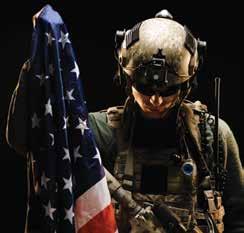
USAF
you ran a knife across your wrists, you called to say you had finally tried coffee.
 By Anneka Johnston
By Anneka Johnston
“It’s disgusting. How do you drink this shit?”
Well, how do you decide your pulse is a song on the radio you’d rather not listen to? I didn’t say that, of course, I laughed and swore to you that coffee just took exposure. I could picture you perfectly: a hospital mug tucked into your lap, one hand on the inpatient phone, the other toying with your bandage. I’m sure you smirked at all the things I didn’t say. Four years of medical education, and I still don’t know how to talk to those who wish to die. This is nothing like coffee. The bitterness does not ebb the more I speak of suicide. I will always feel that I am burning my tongue, that I am screaming into a heavy wind. My words, my reason, thirteen years of friendship are all paper airplanes when compared with your desire to end your own life.
© 2023 by Anneka Johnston, in the publication, PULSE voices from the heart of medicine. Published with permission from the author and PULSE magazine; and with our thanks to them. ~the editors
Anneka Johnston’s devastating poem speaks to the persistent helplessness of those confronting suicide. Most striking of all is the powerlessness of the narrator to know what to do.
Yet at the heart of this interaction is also what matters most – connection. The coffee, emblematic of the narrator and her friend’s enduring friendship, also symbolizes presence. And it is in that presence where people seeking to help those with suicidal ideation can help the most.
In multiple studies, community – or “social support” – is a major way anyone can help prop those confronting self-harm. In more specific terms, studies “found that controlling for a variety of relevant predictors, social support was associated with lower likelihood of having a lifetime suicide attempt.”
That is, community makes a difference.
And this makes sense. Depression linked to suicide is often a product of “low belonging and high burdensomeness.” When we feel lonely and – worse – like a drain on loved ones or society, depression can develop. While there are many contributing factors to suicidal ideation among Veterans, it is clear that simply having community can make a tremendous difference.
Johnston’s poem reminds us of the importance of sitting with friends and solidarity. The way to support your Veteran friends or family is just to be there. Presence doesn’t need words or activities; there is power in the simple gesture of sharing a cup of coffee.

In the past few issues of AHERO Magazine, we have proudly featured the work of Dr. Thomas H. (Ben) Suitt, a contributor to the extensive Watson Institute’s Cost of War project, which won the U.S. Peace Prize in 2022.
Dr. Suitt’s contribution to that project, a 139-page deep dive into the difficult subject of Veteran suicide as a response to war injury, addressed the specific conditions and reasons behind the post-9/11 rise in its rate. Recognizing the wisdom in knowing as much as possible about “the enemy” (in this case Veteran suicide), we have been pleased to continue to present excerpts of his work.
The poem here by Anneka Johnston, about trying to deal with a friend’s attempted suicide, is a reminder that the trauma of suicide, or its attempt, never has just one victim. It is always shared. How to keep a friend, someone we love, even a patient, from its grip or destruction can be, for many, their greatest challenge. For AHERO, it is the nature of the task at hand.
~ the editors
1 Kleiman, E. M., & Liu, R. T. (2013). Social support as a protective factor in suicide: Findings from two nationally representative samples. Journal of Affective Disorders, 150(2), 540– 545. https://doi.org/10.1016/j.jad.2013.01.033
2 Joiner, T. E., & Silva, C. (2012). Why People Die by Suicide: Further Development and Tests of the Interpersonal-Psychological Theory of Suicidal Behavior. In P. R. Shaver & M. Mikulincer (Eds.), Meaning, Mortality, and Choice: The Social Psychology of Existential Concerns (pp. 325-336). Washington, DC: American Psychological Association
Explores religion in the US military through a lived religion approach Investigates how religious resources and traumatic events affect the lives of Christian Veterans.
Draws on post-traumatic theologies to suggest new approaches.
Serving in the military is often a disruptive event in the lives of those who join, precipitating a reassessment of the service member’s ethical sensibilities or, tragically,
resulting in lasting moral injury and trauma. The military experience compels them to navigate multiple identities, from citizen to warrior and back. Their religious identity, sometimes rooted in a civilian religious community, can be altered by military participation. Through a series of inductive, in-depth qualitative interviews, Suitt explores how varied religious resources and potentially traumatic events affect the lives of post-9/11 Veterans who once or currently identified as
“Listening to the stories of post-9/11 veterans and chaplains, Suitt reveals the complicated role religion plays in the morally fraught arena of war and the equallyfraught return to civilian life. This is a moving and deeply insightful account that matters to all of us.”
~ Nancy Ammerman, Boston University, USA
Christian. Adding to existing research on moral injury, it traces how military chaplains, ethics education, just war theory rhetoric, and formal religious practice supplied by the military alter the course of service members’ moral lives. These narrative trajectories reveal how Veterans use Christian faith or other systems of meaning-making to understand war and their identities as service members and Veterans.
“Insightfully, Suitt shows that Christian religiosity, as used by the military to inculcate a warrior mentality, can create trauma as well as help heal it.”
~ Stephanie Savell, WatsonInstituteforInternational & Public Affairs, USA
“Through harrowing and heartening stories of Veterans, Suitt makes a compelling case that faith in a warrior-god heightens risks for moral injury and explores the healing possibilities of a post-traumatic God who suffers in solidarity with those who suffer.”
~ Rita Nakashima Brock, Senior Vice-President & Director of Shay Moral Injury Center, USA

By 2014, according to data from the U.S. Government Accountability Office and Dept. of Defense, there were at least 230 US Military burn pits in Iraq and Afghanistan. Garbage and highly toxic materials were burned in and around, among other military installations, Camp Leatherneck in Helmand Province, Afghanistan.
In his report here, USMC Veteran Dave Pizana hails the brave actions of Marines Michael (“Mikey”) Miller and Dan Mullins, members of the battalion operating in Helmand Province, and of Pizana’s platoon that provided convoy security to the Leatherneck
area. He shows himself as clearly proud and grateful to have had such courageous men with him during many combat missions.
Here, too, is the story written by Amy Mullins, Dan’s wife, reflecting the hope and love their life together began with and continued to sustain them through deployments and war … but at length couldn’t stop the sorrow and loss in which it ended.
Because what Amy and Mikey’s wife, Summer, and Dave Pizana could not have known at the time was that Miller and Mullins would eventually pay a terrible price for having answered their nation’s call. Both had survived
the immediate lethal danger inherent in the risky positions they took up to protect their brothers in arms. Tragically, they would not survive the cancers that have taken many of our still youthful Veterans who fought those wars.
Theirs were cancers that medical experts and (finally!) the VA agree most likely resulted – and are still resulting – from exposure to the toxic fumes and smoke of the fiery burn pits that poisoned the air they breathed while laying their lives on the line a world away on our behalf.
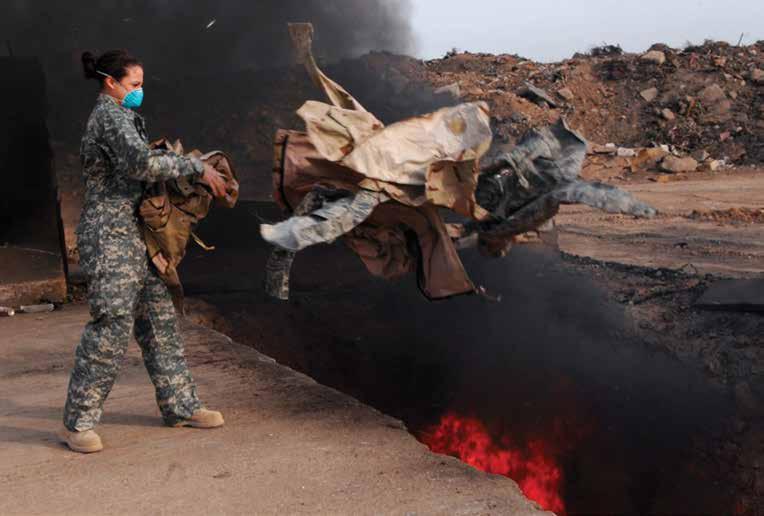
While part of the 8th Engineer Support Battalion at Camp Lejeune in 2008, some of us were assigned to form a security platoon made up of augmented Marines from companies within the command. Following Corps tradition, each of us was a trained Marine rifleman from one or another military occupational specialty (MOS).
Our security platoon was of a type that had already deployed in Iraq with great success. It was responsible for area and convoy security, convoy navigation/lead, route clearing, and medical evacuations.
At this time, Marines were required to put in long hours, often including getting licensed on armored vehicles ranging from the high-mobility, multipurpose wheeled vehicle (HMMWV, or “Humvees”) to three different mine-resistant, ambush-protected platforms, or MRAPs. Marines also had trained for countless hours on weapon systems.
With only four sergeants in the platoon, everyone was expected to step up. As leadership, we asked for more from – and placed more on – our Marines. It was during this time especially that E-3 Daniel (Dan) Mullins and E-3 Michael (Mikey) Miller began to stand out as Marines with sound leadership abilities and enthusiasm to learn even more.
Both would soon be promoted to the rank of corporal (E-4). Those of us in platoon leadership saw the reasons for that. We respected them as vital to the strong NCO core we had built within the platoon.
SPRING 2009, HELMAND PROVINCE, AFGHANISTAN: A TIME OF CRITICAL SECURITY NEEDS
By Veteran Dave Pizana, USMCThe first two months of this deployment did not allow for full use of our security platoon’s true strengths. Nevertheless, we conducted weapons training and staged convoy procedures and downed-vehicle drills. By working on different ways to clear landing zones for our nine lines (emergency medivac requests), we developed a technique since used often to great success.
Miller and Mullins both participated in this. The creativity and ability of these two Marines to “think outside the box” led to the fine-tuning of our procedures. Both were soon leading classes on weapons and medivac procedures in areas where the threat of IEDs was high.
Our security platoon now began to be used as security attachment to convoys leaving the Leatherneck area. At the time, there were only two LSA’s, but the versatility and proficiency we provided were so good that we began to provide security for other units. Mullins and Miller would often be vehicle commanders responsible for the Marines they carried.
We were assigned to provide escort and security for logistic and resupply convoys to and from the Leatherneck area to the town of Now-Zad. The channelized (funneled) terrain there made it easy for the Taliban to place IED’s through the narrow choke points and areas. Our vehicles were hit multiple times.
At one point as the convoy was moving from Now-Zad back south, a vehicle was struck by an IED. We began to get mortared by the enemy. Mullins was in the turret of his vehicle manning a 50.cal machine gun. Spotting the enemy mortar team, his vehicle began to
move to a better angle to engage them. In a coordinated effort with the gunners in other vehicles, he was able to laydown fire with his weapon system and eliminate the threat.
Over the next several weeks, the platoon continued to provide security to Now-Zad convoys, each time getting hit by one or several IED’s. This is where Mullins and Miller along with every other member in platoon showed courage.
Although we rotated as much as we could to share the load during the most dangerous situations, it wasn’t unusual that our Marines would almost argue about who would be in the lead vehicle. That would be the one most likely to be hit. But it wasn’t recklessness or being heroic that drove these Marines to want the lead.
Instead, it was their love and respect for their fellow Marines. They knew something was likely to happen, that someone would get hurt. “But if it has to happen, it happens to me before one of my brothers.”
I also recall many times that Mullins and Miller put themselves in danger outside their vehicles as they swept their metal detectors looking for IEDs before we could be hit. For me, knowing these men, it was always so humbling to observe them in action. They always fought for one another – each of them caring and watching out for the Marine to his left and right and always trusting that those Marines were doing the same for him.
December 2, 2023, marks the first full year after the loss of her husband, decorated Marine, Daniel (Dan) Mullins. Time moves on, but Amy’s devotion to her husband remains.
Amy and Dan met after high school. She was from Washington, he from Florida. “My family is a fishing family. We would go fishing in Alaska, and in the summer of 2001, Dan came up to Alaska to fish, too. We met there.”
It was a long-distance relationship but eventually, Amy made the move to Florida. “I wanted to be with Dan, and I loved the warmer weather,” she said. Dan, who planned to join the Marines, was studying engineering. Amy was in pre-nursing, working as a CNA. Dan enlisted in 2006 and, following boot camp that same year, the couple were married.
They bought a house in Jacksonville, North Carolina, close to Camp LeJeune. Amy was pregnant when Dan had to deploy. That first deployment wasn’t difficult as they communicated via Skype and phone calls. “It went pretty smoothly,” Amy remembered. “He wasn’t present for our son, Aidan’s, birth, but he met him seven weeks later, when he returned from Iraq.”
Their relationship was strong. “Dan had no PTSD symptoms setting him off,” Amy said. “He adjusted to us being a family of three. Aidan was a good baby, and Dan was pretty easygoing. He grounded me. We were really soulmates.”
In 2008, Dan left for Twentynine Palms, California, to train for deployment to Afghanistan. But when Amy became very ill and was hospitalized with something called “C Diff,”* her chances of survival uncertain, Dan was sent home. Thankfully, Amy made a full recovery.
In May 2009, with Amy pregnant again, Dan received orders to deploy to Afghanistan. “This time was very stressful. My husband could handle pressure, but this was an active deployment.”

That September, Dan suffered multiple traumatic brain injuries (TBI), and a severe back injury that caused him chronic pain. He was placed on medical leave from the Marine Corps, which meant he was home for the birth of their second child, Mason. But life had changed. “It was rough,” Amy said. “The day I delivered, Dan was in the emergency room with terrible migraine pain. But even though my labor was very quick, he made it in time for the birth.”
After two years of the evaluation process, Dan was medically retired. He wanted to remain in the military, even though he was dealing with depression and disappointment. “His mindset was that he had failed and let his fellow Marines down,” Amy said.
Adjusting to their growing family was sometimes a challenge. “Both boys would want my attention at the same time and cry. Dan was a good father, but that could be hard,” Amy said.
The couple sold their Jacksonville house and moved to Washington where her family could help out while Dan was working with the Department of the Navy in Keyport. Amy and Dan soon had their third child, Landon.
While 2013 had been good, toward the end of it, Dan began having severe headaches. On January 20, 2014, he underwent an MRI and the doctor spoke with him right after. Amy, waiting at home, recalled how she was not prepared for her husband’s news: “Dan walks in the door, looks at me, and says ‘I have a brain tumor.’ I thought he was joking, but he said no.”


His medical care was good. Dan was seen by his neurosurgeon and his treatment program moved pretty quickly, with his first surgery on February 4th. About 75 per cent of the tumor was taken out, leaving a portion along the brain stem that couldn’t be removed.
A side effect of such surgery is swelling of the brain. “My husband was pretty tough,” Amy said. “I’m making sure he's doing what he needs to do, but one day he starts to experience agitation, holding his head, having a severe headache. His eyes were rolling back. I called 911. Dan’s mom who was there kept screaming, trying to keep him awake.”
He was medivacked for emergency surgery. “I got down on my knees and prayed,” Amy said.
Later, the surgeon told her that Dan had gotten there in the “golden hour.”**
“We were blessed.”
Dan didn’t seem to lose anything; his speech and personality weren’t affected. But he was diagnosed with an aggressive, rare form of brain cancer called astrocytoma, grade 3.
Six weeks of radiation and six months of chemo wrapped up that November. “They looked at his scans four times a year, but it looked good,” Amy said. “Dan had changed his
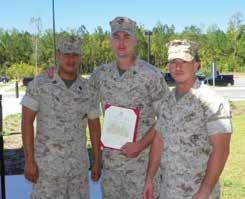




diet – no processed foods, alcohol, or caffeine. He ate a grain-free, no-added-sugar, alkaline diet. He’d tell me, ‘I choose to live’ and did that phenomenally well, staying active and working full time.”
In 2019, following routine MRI scans, Dan and Amy received news they had hoped never to hear. The tumor had begun to grow. “He did various treatments and trials. Finally, in 2022, he had Gamma Knife surgery to hopefully stop the growth.**** But the tumor kept growing and in one spot, was very aggressive,” said Amy. “Still, looking back, I would have him do the surgery again. I would have him try anything to stop the growth. I knew Dan felt the same.”
He developed double vision, and his speech was deteriorating. He couldn’t walk without help or a walker, and by May, he couldn’t stand up. He had to use a wheelchair and to talk slowly to be understood. Unable to take care of himself, Amy became fully his caretaker.
And yet it’s clear that, through it all, Amy Mullins was – and still is – so proud of her husband. “Dan never had outbursts, or got angry,” she said. With obvious emotion, she shared her recollection of Dan’s greatest wish: “He wanted to live longer for our kids, to get better for us. And you could see how much people cared about Dan. He was very loved by our family and friends, even his coworkers. They actually donated over 500 PTO (paid time off) hours for him and our family. They made dinners for us. I was grateful for their support.”
Amy described daily life at the time, admitting that it was difficult. “But I kept a good routine for our boys. And I would take Dan with us when we went out. He wanted to be present for them, for us.” Dan’s mom visited, as well as other close family and friends before he passed away, she added. “And my parents stayed closer to help me with the kids while I cared for Dan the last three months of his life.”
She was there until the end. “He preferred that I take care of him, not anyone else, so I did. And I never stopped fighting for him. I was there until his last breath.” Then, during the early hours of December 2, 2022, Dan’s battle was over.
“Yet he is still here with us,” Amy said. It isn’t definitively recognized, but it’s likely there is a correlation between her Marine husband’s illness and the harmful burn-pit toxins he was exposed to during deployment in Afghanistan. These days, though, Amy continues to honor Dan through her focus on their family.
“The boys remind me of their dad, and I know he would be so proud of them. It is the blessing of the years we had,” she says. “I am strong for him and for the kids, having promised Dan I would be. He never had a negative outlook on anything. He was the stronger one, the calm one, but I have to live a life without him, so I keep moving forward. That's what I do. I keep on going forward in Dan’s honor.”

*Common term for Clostridioides difficile, a serious infection or inflammation.
** Golden hour is a term often used in trauma or emergency care to suggest that an injured or sick person must receive definitive treatment within the first 60 minutes from the time of injury or appearance of symptoms to avoid irreparable damage.
*** Astrocytoma, grade 3 is a more malignant evolution of a previously lower grade astrocytoma, which has acquired more aggressive features, including a higher pace of growth and more invasion into the brain.
**** Gamma Knife surgery is a painless computer-guided treatment that delivers highly focused radiation to tumors and lesions in the brain.
Concerned anticipation of the arrival of Amy Mullins and Summer Miller was palpable. They would meet with us, though grief for the husbands they could no longer hold close was still raw.
Amy had lost her husband, Dan, to brain cancer last December. Summer buried her guy – the friend we all knew as “Mikey” – in April of this year. Like Dan, Mikey had been a casualty of a vicious, incurable brain cancer.
These men left behind their loving wives and three children each, who all adored their dads.
Both dads were much too young, Dan at 40, and Mikey at 46, to be taken from their families.
Miller and Mullins served together in the Corps. were wounded, laughed and cried together. Ultimately, they would die from the same cause within months of one another. Both had served tours in Iraq and Afghanistan, where burn pits were used by the U.S. military to reduce mountains of garbage and toxic materials to more manageable mountains of ash.
Operating in any kind of proximity to these pits would eventually prove a different lethal liability than the bullets, IEDs and bombs our forces understood so well. But by the time the military recognized that this situation could also kill our warriors, it was too late for our two friends.
Each of us has our way of protecting our loved ones from what we have experienced and done. Shared experiences are not always discussed outside our small circle; others are forgotten during a long deployment. We were pretty sure this had been true of Mullins and Miller, too.


But now it seemed that some meaningful stories and lasting impressions of them should be told. That it would be a comfort for their families to hear them and have them to remember and take pride in, going forward.
On this day, we welcomed Amy and Summer to be with us and share in such memories and stories of their husbands.
AHERO even brought USMC Sgt Dave Pizana, a Veteran who had led these men while in Afghanistan. Dave is a big Marine with a thousand-watt smile who commands a room when he walks in. His deep laugh and facial expressions are infectious. He was just what these ladies needed. He was just what we, their caring friends, had hoped for.
Pizana would deliver these stories to the ladies throughout the Orange Beach Warrior Hook-up Weekend. And there would be many tears and much laughter that would go along with honoring these Marines' lives.
We’d arranged that our group on the third floor of the big, beautiful Easy Breezy Beachfront facility donated by Tracy Trost for the 2023 AHERO Orange Beach event. In the intimate comfort of the area that overlooked the Gulf of Mexico, they could talk privately, share stories, bond, and work through the grief of losing these two great men.
And with waves crashing over the beach below, Pizana was able to tell Amy and Summer of the many ways in which their husbands always stepped up to do their job.
He told Summer about Mikey auguring with anyone who would listen, that he was always mission ready. He talked about how Dan fixed an unfixable piece of equipment. Unlike others sometimes did, he said, these two men never let the situation dictate their attitudes.
We all grew from being part of this small gathering. We saw two strong young women who are determined to give their children the best life possible. Two widows with a resolve to carry on, to lead their families through the coming years without the partners they never thought would die so young. We saw a bond created between them and with the AHERO family.
Although these Marines are no longer with us, their memories and families are. We will be honored to watch their kids grow up and become adults who will never forget the fathers they have lost but who will always still be theirs.
The legacy of these two Marines and the stories of thousands of other Veterans and First Responders as well as active-duty military members and reservists – these are why AHERO exists: to change one life at a time through experiences like the Orange Beach Warrior Hook-Up. To build a community of support that goes beyond the fishing or hunting trip to get at the heart of a troubled mind and provide the help and human connection that can soothe the soul.

© 2023 Performed by Rusty Tabor
He said, My brother joined the Navy
But he wasn’t big on boats
My dad did two tours in Vietnam
Even though he didn’t want to go
Me I joined up a little late
But I still did my time
Got myself a purple heart
When I laid it on the line …
The bombs and the bullets couldn’t kill me –
Just gave me a head start on my legacy …
When I meet my Maker
And the battle’s finally won
There in the arms of Jesus
I pray he says well done
When you read my headstone
The dates are all you’ll see
But it’s that dash … in between
That gave me a head start on my legacy
Now I coach football and little league
For my two rowdy sons
And my baby girl just turned 18
She gets everything she wants
The love of my life who said yes twice
Stands beside me strong
Even when we got the news
That I might not be here long
The cancer and the chemo hasn’t killed me –
Just gave me a head start on my legacy …
© 2023 Music & Lyrics by Kevin Adair, Mike Corrado, Jeff Silvey and Rusty Tabor (Music4AHERO Team)
Recorded at @harmonyhilltn Shelbyville, TN and Shoreline Studios, Wilmington, NC



Back in 2007, a Veterans organization was founded to raise awareness and funds to accommodate treatment and special enabling devices. Two particularly significant breakthroughs were “hyperbaric oxygen therapy” (HBOT) and robotic wheelchairs that actually climbed stairs! Both innovations were new to the Veteran community, to the VA and other government agencies, and to the public in general.
The amazing claims about what they could “do” were often met with questions or doubts, especially with the high cost associated with the practical use of them. Because – who could afford it?
The answer was, pretty much nobody.
So it came down to this: If anything aboveand-beyond the usual sympathy or drop-inthe-bucket response was going to happen for the new generation of drastically wounded warriors, some seriously motivated folks were going to have to show up.
And they did! As a group, these individuals brought the lessons of their own difficult rehabilitation with them. Each remembered very well how they’d struggled through their own combat injuries from earlier wars. They knew the suffering these younger men and women were facing as they struggled to reintegrate into civilian life while dealing with the physical and emotional pain of their wounds.
Proud to say, I was given the opportunity to participate in this undertaking. And I was able to do it with some friends who just happened to be awesome individuals, both
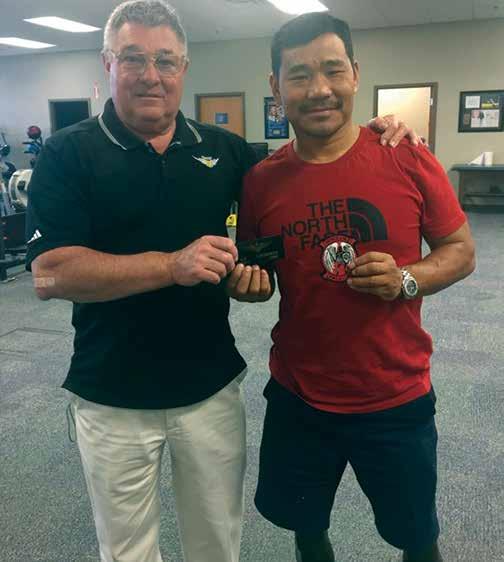

in the Veterans assistance volunteer side of the house and the Veterans themselves who received these therapies and enabling devices!
FOUNDED AND SUPPORTED BY RETIRED MARINES AND NAVY CORPSMEN
The group first met at a bar in Pensacola. Immediately, an organization was set up, and their mission was formulated. Help was on its way.
The organization achieved many great things. Its members encouraged and supported new innovations in therapy and equipment, such as the special prosthetics in development, which promised to meet the needs of severely injured individuals.
Meanwhile, the quality of life that lay ahead of our returning wounded Veterans had been full of the sorts of changes and challenges that these new or improved therapies, devices, and prosthetics addressed. Many opportunities could open for them once they overcame the disabling aspect of their wounds. They could go on to pursue old interests or new skills they had thought no longer possible – and even excel in them.
Having met their goal of bringing awareness of and support for changes that gave our severely wounded access to these innovations, the group’s members moved on to supporting various other VSOs and worthy organizations with similar goals.
As one who has always been motivated to help folks, this left ME inspired to go on and meet many of the incredible people who have benefitted from these innovative developments: the now-enabled wounded Vets and their “enablers” who helped them get there!
My greatest pride is in being able to assist, in small ways, in the grand scheme of good things. I may not always be the answer to the need for expertise or resources, but usually I
KNOW A GUY …
I first met two of my most respected and revered friends when they came to the US from their home countries for Hyperbaric Oxygen Therapy (HBOT) treatments for expeditious wound healing. Corporal

Vincent (“Vince”) Manley, served in the Royal Marine Commandos, UK, and Corporal Hari Buddah Magar, from Nepal, served with the UK Royal Gurkha Rifles.
Both fought gallantly in the Afghanistan War. Vince lost both his legs to an IED – one above and the other below the knee; Hari lost both of his legs above the knee, also to an IED.
The two were here in the US to undergo HBOT treatment, which greatly shortens the healing time for wounded Veterans requiring
prosthetics. It also aids in improving – in some cases curing – symptoms of traumatic brain injury (TBI), including post-traumatic stress, which, if not addressed, can, and too often does, lead to suicide.
My friend Master Chief Thomas “Doc” Eagles, (USN Ret), and I had the honor of working to help both Vince and Hari, as Doc and I were both Vietnam-Veteran members of various VSO advisory boards. We all soon became great friends through the HBOT


“Dives” and the events we attended together while they were in the States. We enjoyed the terrific Lt Dad Band concerts with Gary Sinise and working at events with the FDNY and Tunnels to Towers Foundation to get robotic wheelchairs for Veterans back in the early days post-911.
Hari and Vince eventually went home to the UK. Hari returned to his calling as a mountain
climber. Vince returned to excel in kayaking, rapids rafting, scuba diving and skydiving. But they remained friends. So, after Hari took his fight to the United Nations to get the ban on “disabled persons” climbing the famous Mt. Everest peak lifted (and won!), Vince climbed along with him as far as to the Everest Base Camp. And later, he would be overjoyed to congratulate his friend Hari for achieving
the so-called impossible: being the first double, above-knee leg amputee to climb to the top of Mount Everest!
To say that I’m proud to know Vince and Hari is a gross understatement! Semper fi, all! ~ Frenchy
On November 4, 2023, Shad Meshad, President and Founder of the National Veterans Foundation, was inducted into the US Veterans Hall of Fame, in Atlanta, Georgia.
To say the 2023 Induction ceremony was impressive is an understatement. The ceremony opened with a uniformed color guard from the Georgia Youth Challenge Program, commanded by 1st SGT Scott. They led the inductees and the Hall of Fame leadership and board members into the ballroom. Retired Air Force Veteran Shakia Garrett sang the National Anthem. CoSpeakers were CMSGT David Nordel and documentarian Nicole Amelio Casper.
A diverse group of seven Veterans, men and women, were honored, some posthumously, including Gen. Colin Powell, SFC Modesto Cartagena de Jesus, and Sgt. Henry Johnson (who served in the First World War). Also inducted with Meshad were Medal of Honor winner SPC5 Dwight Birdwell, Admiral Linda Fagan, and Ranger CPT. Moses West.
Shad served during the Vietnam War, counseling soldiers in the field who were suffering from a multitude of psychological and emotional problems resulting from their combat experiences. It was the first time the Army had deployed mental health service officers to a combat zone.
On his return to the US in 1971, he headed to California, having his own difficult transition out of war and the military. When Philip May, head of the largest VA psychiatric unit in the country, wanted to know why Vietnam Vets were not coming for treatment,
By Cathie Sandstrom
he asked Shad, who told him the VA was hostile, unwelcoming, difficult to navigate. Transportation was an issue.
May offered him a job; he refused it. May was persistent. Eventually Shad agreed to take a temporary assignment. He traveled the streets of Los Angeles, anywhere Veterans gathered. Self-isolating and self-medicating, Vets were becoming a social problem.
But Shad looked like them and he spoke their language. He established “rap groups,” in which those struggling with what they’d gone through could share their experiences.
The press picked up the story about the “Mad Man” working the streets in LA. Capt. Max Cleland (U.S. Army), a severely wounded, triple-amputee Vietnam Veteran and aide to Senator Alan Cranston, traveled out West to see why all the buzz. He met Shad, the “Mad Man” himself, who soon was pushing Cleland’s wheelchair all over Venice Beach and VA hospital grounds in West LA.
Cleland (who died in 2021 but would first become a U.S. Senator himself, in 1996) agreed that something had to be done for the Veterans. If it wasn’t, he said, “we’ll lose all of them.”


Sen. Cranston invited Shad to Washington, where he co-authored and lobbied for the Vet Center Program’s storefront community clinics. Today, Veterans are receiving mentalhealth counseling in more than 300 such clinics throughout the country. Shad, Cleland and Cranston also initiated the National Vietnam Veterans Readjustment Bill, passed into law in 1979 to address the shameful discrimination in hiring that Vets faced as they struggled to re-enter civilian life.
In 1985, Shad founded The Vietnam Veterans Aid Foundation (VVAF), a non-profit helping Veterans and their families with a toll-free number later established to facilitate that process. In truth, by the 90s, Shad’s work was so respected, he was sent to Russia to help counsel soldiers returning from Russia’s war in Afghanistan. Though its name was changed in 1992 to the National Veterans Foundation (NVF), the support it provided never wavered.
Then, as the 21st century opened on the cataclysmic 9/11 attack on our own country, government officials called Shad Meshad to New York’s Ground Zero to help counsel our bravely struggling First Responders.
HIS
Thus on this night in 2023, Shad was deservedly honored along with a diverse group of six others, some posthumously, including Gen. Colin Powell, SFC Modesto Cartagena de Jesus, and Sgt. Henry Johnson, who served in the First World War. Also inducted with Meshad were Medal of Honor winner SPC5 Dwight Birdwell, Admiral Linda Fagan, and Ranger CPT. Moses West.
NVF Board member Jeff Morris flew in from Western Canada on Friday night in time for the casual dinner for inductees and the Hall of Fame board. Next day, Eric Lardiere, former board member of many years, arrived. Among Veteran friends were AHERO’s own Norm “Frenchy” La Fontaine, who knew and advocated with Shad for James “Sneaky” White’s release.
Sneaky’s life of dramatic turns, challenges, and triumphs was told in previous issues of AHERO Magazine. One of the most decorated helicopter pilots in Vietnam, he overcame much and now runs the NVF Prison Outreach program for incarcerated Vets that he designed.
Also attending the festivities was Sgt. Major Jesse Acosta, a USMC Veteran, who was blinded in combat in Iraq. The NVF stepped up
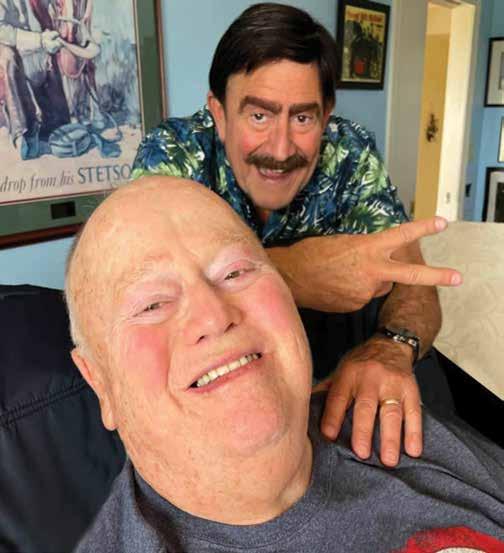
more than once to fight for Jesse’s VA benefits. Jesse was the one whose solo cheer, “SHAD!!” rang out every time the Master of Ceremonies called Shad’s name to the crowd of over two hundred people.
Echoing Jesse’s shout were the members Team NVF – our staff, volunteers, Vets, family and friends – all of us proud of Shad Meshad’s commitment and accomplishments and deeply grateful to the US Veterans Hall of Fame and to Chaplain Curtis Drayton and his staff. They created a wonderful event to honor these remarkable American Veterans!
The commitment to serve ran strong and deep in that room. It was palpable. It settled on us with a kind of reverence.

USMC Vietnam Veteran Everett Cole, who died suddenly on September 1st this year, was an AHERO volunteer who was loved and respected by many. With his gracious and ever-loyal wife, Alice, by his side, Everett shone at every AHERO event, where humorous conversation always produced a twinkle in his eyes and a solemn moment of prayer revealed his inner peace. And certainly at patriotic events and ceremonies, which often prompted his ready, crisp salute.
Everett was born March 7, 1949, in Moss Point, Mississippi, but grew up in the Florida Panhandle towns of Century, Cantonment and Pensacola. In May 1968, Everett joined the Marine Corps. By February 6 the following year, he had arrived in Vietnam – ready, said the Brass, for combat.
According to a story on Everett’s life and passing by writer Martha Poole Simmons in Alabama Gazette’s October 1, 2023, online issue: “His four-month tour of duty in Vietnam ended when he triggered a landmine resulting in catastrophic injuries to his legs. Everett concluded that because his injuries occurred about 10:15 a.m. instead of p.m., he was quickly medevaced by helicopter to a Naval hospital in Vietnam by 10:30 a.m. which prevented his becoming a casualty.
“He also credited God’s hand in saving his life. One hour before he was wounded, the lieutenant leading his unit had the patrol element practice drills to know what to do if someone might be wounded. Everett’s best friend was assigned to carry the radio for the squad, and this was his first patrol as radio man. When the explosion went off, Everett could hear the transmission for a chopper. As it turned out, a chopper with the call sign ‘Lady Ace’ intercepted the message and stated that he was in the air with another wounded Marine and could take a couple more Marines. Back from Vietnam,

Both his left and right legs had been wounded – the right especially grievously.
Eventually he was sent to a US Army hospital in Japan, where more of his right leg was amputated; then to the U.S. for treatment at the Philadelphia Naval Hospital in Philadelphia, Pennsylvania, for four months; and finally to the VA Hospital in Montgomery, Alabama.
It happened that Alice, at that time, was working at the Montgomery hospital as a clerk-typist. In the delightful story she wrote for AHERO Magazine in 2019, a woman who worked in her office introduced her to him, and soon they were chatting. Everett asked Alice out, but she knew he was a smoker, she said, and she disliked the habit. Still, Everett was persistent, and their romance was launched … to continue for a half-century.
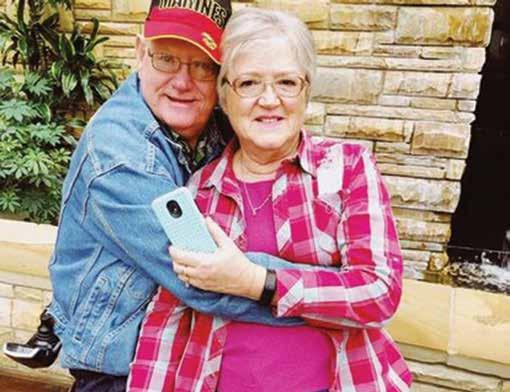


Perhaps that persistence of his saw Everett – and Alice, as his caregiver – through the surgeries, pain, and the agony and frustration of rehab and other tough challenges. Yet they forged a 53-year marriage that, by any standard, was a successful and happy one. They raised three daughters, Everett completing his college education after the second was born, and Everett would begin what became a 30-year career with the VA. Through it all, he and Alice were involved with the community and had fun participating in many recreational and social activities with friends. They even set out together to accomplished Everett’s lifelong ambition to “visit all 50 States for which he had given his legs.” And accomplish it, they did!
In her story for the Gazette, Ms. Poole Simmons offers a quote from him a couple years back: “I have lived my life to the fullest and the best that I could. Vietnam stole my youth. I never had a chance to grow up.” And yet, his loyalty to the nation he served never wavered. She goes on to write:
“[Everett] served as the Commander of the Military Order of the Purple Heart Chapter 2205, whose members have all answered America’s call, and now as combat wounded Veterans, they continue to serve America by helping active duty military, Veterans, their families and those who have borne the burden of the battle. Everett was also a lifetime member of the Disabled American Veterans (DAV) organization and a member of the American Legion. He was active in Veteran non-profit support organizations such as
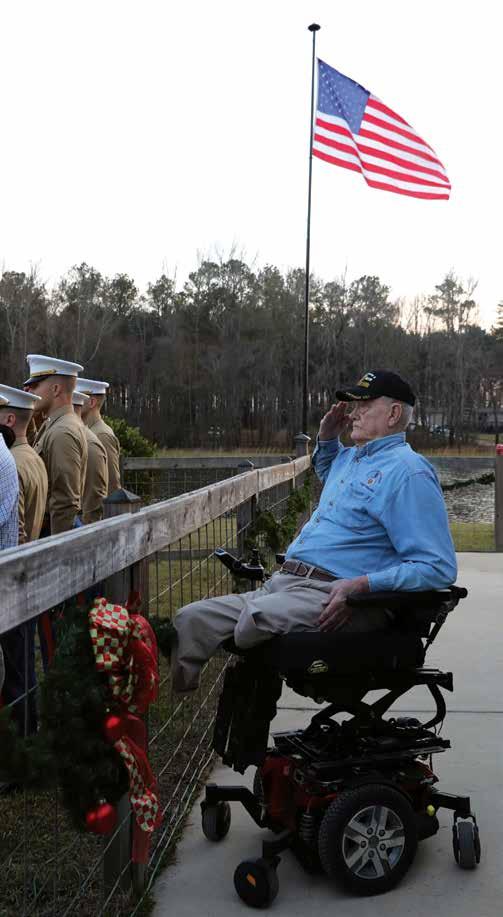

Although Everett suffered traumatic injuries at age 19, he retained his loyalty to the U. S. Marine Corps saying, ‘It gave me the ability to overcome saying, “I can’t.” It gave me the drive to be the kind of man that I should be. I believe in courage, commitment and honor. I’ve tried to live my life by that including God, family and the Corps. My wife deserves the title of Marine as much as I do because of what she has gone through with me. I have always had a wife who listens.’”
At AHERO Magazine, we know this excellent man’s caring and patriotic heart was true, and that he will be sorely missed by his wonderful life partner and wife, Alice, by his children and family … and by his many friends and fellow Veterans.




In a transformative adventure recently, I was pleased to be able, as a retired army soldier, to bring a group of Omega Lamplighters* and their parents on their first camping experience. What made it a remarkably memorable one for us all was that the campsite was at the farm owned and operated by the War Horse Project of the Gulf Coast (WHPGC), which is situated on extensively wooded terrain in Milton, Florida.
WHPGC began with a primary focus of helping Veterans. Recent research, however, has shown that equine therapy can assist in healing others suffering from many different ailments, as well.
The camping expedition was organized by the charitable organization America’s Heroes Enjoying Recreation Outdoors (AHERO), which is dedicated to helping wounded and
injured Veterans and First Responders heal. AHERO provides opportunities for these individuals to come together in natural environments to enjoy activities where they can share, in a positive manner, their concerns and experiences as well as the excellent skills they earned while serving.
Service members both active and retired brought their expertise and camaraderie to this camping trip. As our group was comprised of inner-city kids and their parents who had rarely or never ventured into the great outdoors, this excursion was truly an eyeopening experience.
For many, it was the first time spending nights away seeing stars without the interference of bright city lights. For most, it was being in the unfamiliar serenity of a fully wooded area.
The campsite, nestled in the heart of the Warhorse Project property, provided an ideal backdrop for the adventure. Dr. Sean Hollonbeck, himself a Veteran, has turned his land into a haven of healing through animal therapy. His compassionate approach uses the calming influence of animals to help individuals overcome their challenges, whether physical or emotional. During the camping trip, participants had the opportunity to interact with therapy animals such as horses, dogs, and even a few rescued farm animals. This interaction allowed everyone to connect with nature and experience its therapeutic benefits.
The weekend camping adventure was filled with activities emphasizing teamwork, leadership, and outdoor skills. Service members shared their knowledge and

experiences. In teaching the kids and parents valuable survival and camping skills, they fostered real unity in the group.
As the experience drew to a close, a sense of gratitude and delight at newfound friendships pervaded the farewell atmosphere. For the inner-city kids and their parents, the camping trip had been something of a life-changing experience, expanding their horizons and instilling a newfound love for the great outdoors. For myself as a retired army soldier, and for Dr. Hollonbeck, it had been an opportunity to give back and heal through service.
In a world often marred by division, this camping trip showcased the power to heal that those of us who have served can have when joining with the community to bring others into the solace of nature. Thanks to the dedication of AHERO, individuals who have served continue to make a positive impact in their communities while finding their own path to healing.
I believe this camping adventure will ever be a cherished memory for all involved. As such, it is testament to the enduring spirit of unity and the potential we all have to make a positive difference in the lives of others.


This past November, Veteran Dave Riley, AHERO friend and volunteer, rose to acknowledge his gratitude for being Mobile Bay Area’s 2023 Veteran of the Year. Riley stood tall and strong, an example of a man who has faced down the devils of depression and despair to succeed – against all odds – at living. In his speech, Riley was straightforward on the character of those odds and on the vulnerability within himself that they had preyed upon until he found the courage to fight back. Excerpts from his inspiring speech follow.
(Dave was introduced to much applause)
… Thank you. This is such a tremendous honor.
First, I’d like to acknowledge retired Army Colonel Pat Downing of the Veteran of the Year Committee … [and] retired Air Force Colonel Steve Carey, the President of the Veterans Day Commission. … And, to my fellow honoree, Jo Bonner: You are an incredible patriot and member of this community.
I WOULD CHOOSE THIS LIFE AGAIN
I wouldn’t have said that 26 years ago. No. In 1997, I thought my life was over. When I woke up from a month-long coma, looked down, and realized I was missing my arms and legs, I believed my purpose, my identity, and my capabilities had all been stripped from me.
The amputations saved my life after contracting septic shock pneumococcus sepsis – something I likely picked up in the water while on duty as a Coast Guard rescue swimmer.
My thought at the time was: ‘What was the point in living if I couldn’t do what I loved?’
I had spent nearly 15 years jumping from helicopters into danger saving people’s lives. I loved serving. I loved who I served with. And I loved the purpose behind the mission.
All of that was lost in an instant. At least … so I thought. At the time, I felt like I became the person in the water who needed to be saved – helpless and dependent on someone else for everything. But I would soon learn… and re-learn… and re-learn again how my illness and the resulting amputations were not a death sentence.
Waking up from my coma was a rebirth. A new beginning. The next chapter in my life’s story.
I hope that by sharing a little about my journey and experiences, all of you today, whether you’ve served in the military or not, know that you have something to offer to make this world a better place for Veterans.

The first reason is community.
I grew up an Army brat. Like many military families, we moved around a lot. My father’s career took us all over the country, never really staying anywhere long enough to ever feel settled. That continued for me when I joined the Army in 1976, and then six years
later when I joined the Coast Guard.
In 1990, my family and I moved to Mobile. And we’ve been here ever since. This is our community.
This sense of place is so important for Veterans … to put down roots and surround themselves with people they care about and who care about them. Then, they need to get involved.

Not long after I came out of my coma, a DAV representative visited me in the hospital. He helped me with the paperwork [and] welcomed me into a community of fellow Veterans who, like me, had been forced to find a “new normal.”
For me, DAV offers the familiar support and camaraderie I had known in the Army and Coast Guard. But no matter which branch we were in … we must continue to come together to show appreciation to Veterans for their sacrifices and back that appreciation up with action.
It’s a privilege for me to serve … to help other Veterans. It’s why I’d choose this life
again. When you find a community and get involved, you find purpose … your why … a reason to wake up in the morning.
This was not an easy lesson for me to learn. Depression is a sneaky enemy. Depression tricks you into believing you have no value.
When my brothers and sisters in DAV recognized I was hurting inside they took

action: by throwing me down a mountain. They knew that skiing would inject a boost of adrenaline I’d been missing for so many years.
That was in 2010 at the National Disabled Veterans Winter Sports Clinic co-presented every year by DAV and the VA. It unlocked the world of adaptive sports, redefined my perceived limitations and revealed a sense of purpose. That realization was so empowering. There is life after injury. There is life after illness … after trauma.
That fresh perspective drove me to volunteer my time [and] grew to a national effort in 2016 when I was elected as DAV’s national commander – the first quadruple amputee and first Coast Guard Veteran ever elected to our organization’s highest post to advocate for
Veterans to get the benefits they earned. For every Veteran this helped, I would choose this life again.
THERE’S ONE FINAL REASON: YVONNE, MY WIFE… MY BEST FRIEND
Yvonne has selflessly dedicated her life to being my caregiver. After making one of the hardest decisions anyone would ever have to make — to allow the doctors to amputate each of my limbs one by one to save my life — she made another decision to never leave my side.
Even in my darkest hours, she has been steadfast in her unconditional love. Even as we both age and the role get more difficult, she still tends to every basic need and helps me make it through each day.
She personifies sacrificial love. I’m a better
man because of her and I would live this life a thousand times over just to let her know how much she means to me.
Veterans often get the recognition and thanks of a grateful nation, which are appreciated. But there are so many of us who wouldn’t be here without the selfless commitment of our caregivers. To each of you in that role … thank you for your service.
I hope that whatever point in life you find yourself today, that you, too, would choose this life again. Consider the community you’re a part of, the gifts and abilities you’ve been given. Then turn that into action. Consider volunteering for Veterans … there’s a role and a need for each of you.
Thank you again for this honor.

Just prior to his passing at age 100, an area WW II Veteran was feted by many who have worn the uniform and understand the importance of his and others’ wartime military service to our nation.
I was standing in front of my house in Gulf Breeze, Florida, last spring, when a neighbor approached and introduced herself as Mrs. Janice Park. She walked here often, she said, always staying on the side of the street that would bring her to the first of four US Marine Corps flags that fly in our neighborhood.
“My husband, Robert Park, is a World War II Marine Veteran,” she told me. I understood why she appreciated those flags. Then she added: “On June 3rd, Bob will be one hundred years old.”
“Would you be sure to tell him Happy
Birthday and Semper Fi from a fellow Marine?” I asked.
She agreed. Later, I notified a few folks who I knew would be interested. Soon I learned that things were moving quickly as arrangements to honor this fine Marine were already being made.
Two days before his 100th birthday, I met Bob for the first time. He and Janice had moved here from Indiana in 1991. Bob had
grown up in the small town of Montpelier, Indiana. His high-school class had 25 students, he recalled, and he was class president.
On September 18, 1942, at age 19, Bob had entered the United States Marine Corps. I listened as he described various details of his service. He did not have the DD-214 that later would identify each Veteran’s duty assignments, but he recalled boot camp in San Diego and receiving platoon leadership training at Quantico.
Bob proudly served until war’s end. He was


discharged with the rank of technical sergeant and a Certificate of Honorable and Satisfactory Service in World War II.
JOINING UP: A LOVING FATHER’S WORDS OF ADVICE
“My father was putting me on the bus to go from our little town to Indianapolis to join the service,” Bob told me, “when he said, ‘Just do as you’re told, do the best you can, learn all you can learn … and be happy!’”
Later, as the war went on, his father sent him the inspiring poem, “True Greatness,” by C.E. Flynn and printed here. Bob put it into his billfold and kept it with him always.
As we spoke, Bob described his actions on behalf of his Marines. I could see how deeply committed he was, always adhering to Marine Corps leadership principles. One story he told particularly illustrated this:

A young Marine, Robert Oliver, had come to see him with a letter he’d received accepting him to the US Naval Academy. “What should I do?” asked Oliver, confiding that he wanted to attend the Academy. TechSgt Park suggested that he go to the commanding officer and present the letter. When the young man returned, Bob asked him what happened.
“He just wadded up the letter and threw it back at me!” was the reply. Bob said, “Ok. Let’s go into town, so I can make a phone call.” Confused, the fellow asked, “Why go off base when there’s a phone right here?” Bob (maybe thinking this might be seen as going over the CO’s head) told the Marine: “I can’t use the command’s phone to get you outside assistance!”
Off they went to town, where Bob made the all-important phone call. Three days later, having received a call from a U.S. Senator’s office, the CO yelled for Oliver to report. Sure enough, Oliver graduated from the Naval Academy! Ultimately, he fulfilled his Marine Corps obligation.
After his service, Bob returned to Indiana and eventually married Janice. They had children and, for nearly 20 years, raised Hampshire sheep on their farm in Gaston. Bob also began and pursued a career in the banking industry, retiring in 1987 as executive vice president at First Merchants Bank in Muncie. ONE MIGHTY MILESTONE, THREE CELEBRATIONS
–June 3rd
Several Marines and a couple of corpsman greeted Bob and Janice outside their home with an enthusiastic “Semper Fi, Marine!” His camouflage cover on, Bob smiled and responded in kind.
–June 17th
A larger gathering of family, friends, and coworkers from nearly 50 years in banking celebrated Bob’s birthday at the First United Methodist Church of Pensacola. With nearly 100 in attendance, many shared memories and reflections on how their lives were impacted by Bob and Janice.
These testimonials reaffirmed Bob as a man of character, true to himself, unfaltering in principle; that he demonstrated these qualities as a Marine consistent in his servantleadership style as a Boy Scout Master, a citizen, and a mentor throughout life, and as a husband honoring and respecting his wife,

A man is as great as the dreams he dreams, As great as the love he bears, As great as the values he redeems, And the happiness he shares.
A man is as great as the thoughts he thinks, As the worth he has attained, As the fountains at which his spirit drinks, And the insight he has gained.
A man is as great as the truth he speaks, As great as the help he gives, As great as the destiny he seeks, As great as the life he lives.

Janice, always.
–June 30th
Bob and Janice were quests at a luncheon with fifty-five Marines and sailors in attendance, all paying tribute to Bob for his centennial milestone. As Bob later settled into his car for the return ride home, he sat back smiling and commented, “This was great!”
***
Sadly, this Marine Veteran would pass away later in the summer. There is some solace, however, in knowing that Bob Park, 100 years young, had lived a full life with love and honor – a remarkable citizen of the remarkable country he loved.
Robert Roosevelt Park
June 3, 1923–August 23, 2 Semper Fi, Marine!
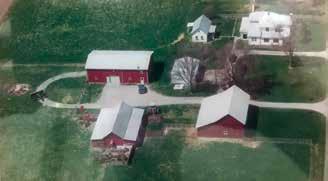
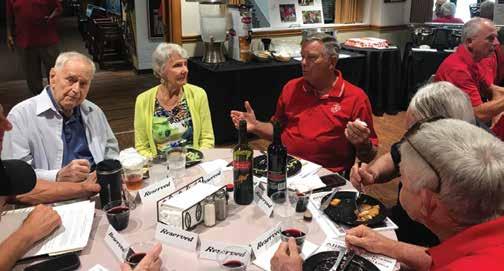

I was born and raised in Boston and grew up an impressionable kid who believed in the WWII heroes of movies and action. Like others of my generation, I revered heroes such as John Wayne, who depicted brave US servicemen on screen, and John F. Kennedy, whose brave action to save the lives of his PT109 sailors at sea during that war impressed us all.
At about age 12, I had set up a shoeshine box outside the main gate of the South Boston Naval Shipyard. This was a time before sailors wore Corfam shoes that didn’t require polishing. I’d be there at the gate to meet the aircraft carrier USS Wasp and other ships. While shining the shoes of arriving sailors before they went to town to meet the ladies, I’d listen to their stories of world travel to amazing ports of call.
At around age 16, I dropped out of high school. Luckily, our high-school counselor saw something good in me and referred me to a dental lab where there was a job opening rather than the factory job I’d figured I could get. In doing this, he helped me gain the selfconfidence I needed. I worked at that lab until joining the service three years later.
The Vietnam War was still in the future as I turned 19. The thought of world travel in the Navy was still strong although I admired the Marines, too, but my medical (lab) experience could help me become a medic, which you could not become in the Marine Corps. Then I learned that Marine-trained Navy corpsmen were needed on the battlefield with Marines. My dilemma was solved: I would travel with the Navy while earning the respect of being a Marine!
By FMF Corpsman, Ed “Doc” Schaier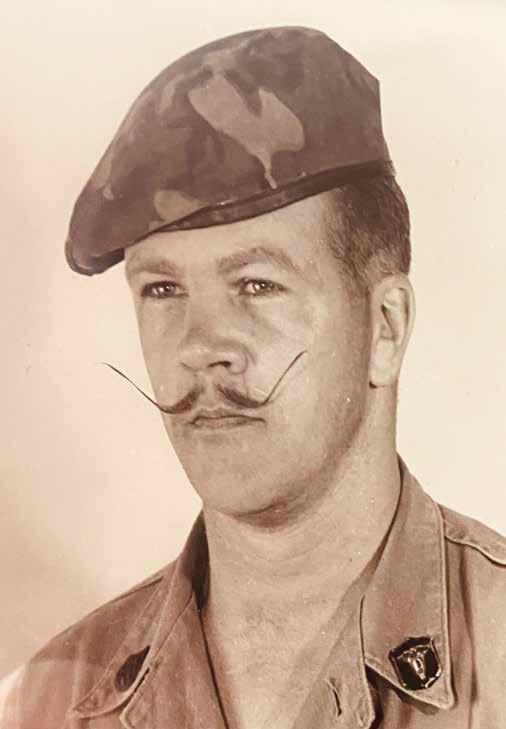
The Field Medical Service School (FMSS) for corpsmen whipped us into shape, showing us how to properly and proudly wear the Marine Corps uniform as FMS corpsmen treating combat-wounded Marines. I also attended the Navy’s dental tech school. Regulations
The military now became my family, and I realized I could achieve much by volunteering. That attitude put me aboard the USS Dixie headed to the Western Pacific for a ninemonth cruise. We visited Hong Kong, the Philippines, and Japan. I was on my way – off to see the world.
After we returned to the States, the job began to feel like a regular nine-to-five. Definitely not what I’d signed up for! I decided to volunteer for FMF, Marine duty, instead.
Eight weeks of field medical training at Camp Pendleton later, I was aboard an overcrowded WWII troop transport ship cruising to Okinawa. There, I volunteered to go with the infantry. This got me transferred to a remote area with the 2nd Battalion, 3rd Marines at Camp Schwab.
We sailed from there to the Philippines, where I got my first ride in an H-34 helicopter, then visited Subic Bay, Kaohsiung, and Hong Kong. Back in Okinawa again, I chose to take training to drive a 5-ton truck, which in time would come in handy; but for now, I elected to get training at another school, then transferred for duty to the Naval Hospital at Chelsea, Massachusetts.
My second Pacific cruise to the Philippines had been cut short because the situation in Vietnam was heating up. In 1964, after the attack by the North Vietnamese on the USS Maddox destroyer (the “Gulf of Tonkin incident”), the conflict between North and South Vietnam was drawing our forces in and quickly becoming war.
After more training, I had transferred for duty to the Navy Hospital at Chelsea, Massachusetts. But I volunteered to go back with the Marines and arrived in-country in August of 1967.
Unfortunately, my new job classification kept me from being out on the front lines. Instead, I was where casualties were treated and the deceased taken to the gravesregistration area, where I would perform dental exams for identification verification, comparing my findings with the dental record of the individual the deceased was assumed to be.
At the same time, eighty miles north of Da Nang in the Phu Bai area, our medical company was treating patients in the field from the 1st and 5th Marines. Their only



fuel truck was a gas-driven, fifteen-year-old Studebaker 5-ton, considered unable to go that distance to resupply them. A newer multi-fuel vehicle wouldn’t be available for five months. But I’d had maintenance training on the 5-ton, and I had the driver’s license I’d volunteered to get three years before, so I managed to convince my CO that I’d be able to keep the old Studebaker running. Throw in that they needed me to work triage and graves registration up north, and I was in!
Getting out to join Task Force X-ray and keeping that old Studebaker 5-ton in service required leaning heavily on the Seabees in Phu Bai and the Marines of 7th Motor Transport Battalion, 80 miles to the south in Da Nang. In return for their help, I gave grooming clinics and a supply of surgical bone wax (which had a great adhesive and other qualities) to all who had mustaches.
Grooming standards for Navy and Marine personnel had been relaxed with the focus being on staying alive. So just about every male grew a handlebar mustache. Luckily, I had hair clippers and a good supply of wax. Of course, I possessed a well-groomed handlebar, myself!
WORLD TRAVEL REALIZED; QUESTIONS LEFT UNANSWERED. YET GRATITUDE REMAINS
All through the Tet Offensive, I tried to reconcile why we were taking so many casualties. I would learn later that my nineteen-year-old cousin from Boston had been killed. His parents had proudly sent their Marine son off to war and never recovered after receiving his remains. I’ll never fully get over the more than 58,000 losses sustained by America’s families in that war.
Real answers were and are hard to find or understand, but I was forever thankful for our helicopters and brave pilots and crew who managed to get the wounded to us; and for our MUST (Medical Unit, Self-Contained, Transportable) Quonset huts.
In the direct hit our MUST took from a 122 MM rocket, it absorbed most of the shrapnel. In our full ICU, only two patients sustained flesh wounds, which were minor. Had it been a conventional structure, we would’ve lost up to 95 percent of the patients and many of the brave medical staff whose task it was to care for them.
Yes, many grave mistakes were made about and in that war. I am still so thankful to Our Lord for those who still love America, believe in the Constitution, and are willing to fight for its continued existence!





If you’re from Pensacola … if you’re current or former US Air Force … if you’re a student of America’s homegrown heroes, you will probably have heard the name Daniel R. “Chappie” James, Jr.
If so, it’s quite likely that you’ve seen halfcentury old photos of a tall, good looking fellow with a 1970’s mustache, wearing a flight suit and standing in front of a McDonnell Douglas F-4 Phantom fighter-bomber. You might have taken note that the chap was a USAF Force general.
AN ERA WHEN DESERVING AFRICAN AMERICANS WERE ROUTINELY PASSED OVER FOR HIGH RANK
James put the shameful lie to the practice of discrimination in military promotions. Not only did he earn the rank of general – he went on to collect stars. Four of them.
He was the first African American in US military history, across all the services, to achieve the rank of 4-star general.
A QUICK TUTORIAL
To contextualize for those unfamiliar with the stats at this altitude, right now there are only 11 4-star generals in the United States Air Force. And in the last 80 years, there have only been 226 generals in our entire military who have held that rank!
James earned his 4th star in 1975. It would be another 12 years before the next African American was tapped to scale those heights. It seems that senseless, unfair practices die hard.
So his community is rightfully very proud of the great man for what he stood for, and what, to all of us, he still stands for today. Interestingly, though, the more you learn about General James, the more you begin to respect the man himself above even his achievements.
All told, the building of the glorious bridge named for him and the installation, at its Pensacola end, of a permanent memorial to General James – a pavilion bearing his statue with an actual F-4 Phantom aircraft behind it –will have taken six long years.


General ”Chappie” James Jr. Memorial Foundation founder, rainmaker and Chairman, USMC Captain Cris Dosev, asked me to attend this year’s 103rd Birthday Celebration Gala at the Corinne Jones Resource Center, on February 4.
Mr. Dosev tasked me with writing a piece for AHERO Magazine, focusing on “education”.
Initially, I thought this was a secondary story. Why not talk more about this incredible man’s life of achievements?
As I listened to Cris, and to General James’ granddaughter, Ms. Brittany James, and his grandson, Captain Frank Berry III, I started to comprehend what he was asking.
“Chappie” James didn’t cease to be on February 25, 1978. He’d planted seeds that took root, grew, and have blossomed, ever since.
Yes, he passed from this life 45 years ago. But his spirit, which is his true legacy, is still very much alive. Not only in the greater Pensacola area, either, because by now this general has inspired generations of young folks here in the USA and beyond. And it seems to be gaining in strength every year.
Captain Frank Berry III had both a smile and tear in his eye, as he related some of the stories about his grandfather. “Even as a general, at chow time, he would often excuse himself from the Officer’s Club, and go eat with the enlisted airmen and sing karaoke!”
WAY MORE INTERESTED IN THE “COLOR” OF YOUR HEART, THAN THAT OF YOUR SKIN
James did not see negative divisions. Put another way, you could say that he mainly saw unity. Between ranks, between races, it seemed as if distinctions only strengthened the whole.
For while he had faced serious racist hurdles as a young man – his recruiting officer reportedly screwed up his application form, actually hurling it to the floor – he didn’t allow anything to color his judgement. It merely fueled his fire.
He would just rise above it. To 63,000 feet, in fact, and at close to Mach 2!
The relentless pursuit of excellence was at the core of this man. But more than that, he was driven to inspire and educate.
That drive to set the highest goals, achieve them, and inspire others to learn and lead, defined James’ character and stemmed from his mom, Lillie Anna James.

In the early 1900s, as yet only in her twenties, Mrs. James started the first school for African American children behind the Pensacola home she shared with her husband, Daniel, and their family. For decades and now, long after her death, she was and continues to be remembered as a much revered, highly effective educator.
Even today, in the Panhandle area, you might hear someone exclaim that, “Oh, yes, my grandma was in Miss Lillie’s kindergarten (or other) class!”
Ultimately it was the legacy of Mrs. James’ foresight and caring that would, nearly a century later, culminate in the STEM programs being offered today in her famous son’s name. To say nothing of the Chappie James Flight Academy in Pensacola that encourages area African American teens to enter the field of aviation.
The tradition of education and excellence, in the James family, and of rising above the turbulence of division to succeed, is long, and strong. Evidence of who set the tone for this is on the business card of General James’ granddaughter, Brittany James. The quote it carries comes directly from Miss Lillie, her great grandmother.
IT READS, “THOU SHALT NOT QUIT.”
No, ma’am. We will not.
As you drive across the General “Chappie” James Memorial Bridge and catch sight of that F-4 Phantom II once it’s in place, consider the man who followed the rule his mom set down – her Eleventh Commandment – to reach his summit:
How hard it was for him to even get off the ground.
How high he soared.
How many he raised up.
How you can uplift others.
Eddie Rickenbacker - WWI Ace with 26 aerial victories and MoH recipient
Daniel “Chappie” James, Jr – 1st African American USAF 4-Star General; 3 wars
Robin Olds - Triple Ace of WWII and Vietnam
Chuck Yaeger - Record-setting test pilot with a career spanning 70 years


“One trailblazer will commemorate another” wrote Greg Hadley in Air & Space Forces Magazine in June 2022. He was speaking of sculptor Ed Dwight, the former Air Force pilot who was tapped to create the magnificent statue of the late AF General Daniel “Chappie” James, Jr. The statue would stand upon the pavilion at the Pensacola side of the completed Pensacola – Gulf Breeze, Florida, bridge gracing the general’s name.
By Connie ConwayEd Dwight, also a barrier-breaking African American, had already given years of impressive service to his country when, long retired from active duty as a fighter pilot, test pilot, and astronaut candidate, and now a renowned sculptor, he was selected to create the statue of the nation’s first Black four-star general.

As a USAF fighter pilot and test pilot, Dwight achieved more than 2500 tactical jet-flight hours by the age of 29 and was selected to be the first Black astronaut by President John F. Kennedy. In February 2023, Dwight graciously appeared at a fundraiser for Pensacola’s Chappie James Museum, where selections of his impressive work were on display.
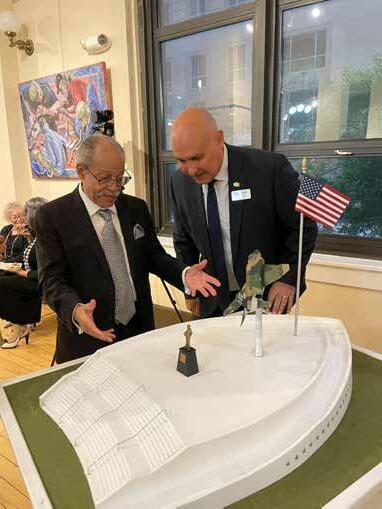
The Emerald Coast Veterans Alliance (ECVA) is a 501(c)(3) non-profit public charitable organization founded in 2019. It provided an opportunity for our neighborhood to celebrate Veterans Day – at first simply involving a golf outing and evening ceremony to the mission-driven organization we have today. That mission is to explore and secure available avenues of funding in support of Veterans in need who are living in the greater Florida Panhandle area.
ECVA’s membership consists entirely of volunteers from our community. And unlike many other Veteran-centered organizations, we ensure that the money generated by our event here stays here to help our resident Veterans.
Our motto is “no Vet left behind,” which of course is derived from the Soldiers Creed. Each of the uniformed services has a set of principles that help shape the culture of that service. In the Army, those principles are contained in the Soldiers Creed as one tenet of the Creed is, “I will never leave a fallen comrade.” For us, that doesn't just mean fallen on the battlefield.
Veterans Day 2023 marked our organization’s fifth year hosting our annual Veterans Cup Benefit Golf Tournament. In 2022, our 4th annual tournament was successful enough for us to be able to provide donations totaling $25,000 to Pensacola-area Veterans in need. We expanded to a third location with a follow on day of competition for the top three finishers at each location –and all three locations were sold out!
Approximately 76 four-person teams competed in large part due to funding from major donors First Corps, Inc., Poarch Band of Creek Indians, Florida Power & Light, and HearingLife. As of this writing, our revenue will likely exceed $60,000. Foundations to receive funding from this will be determined soon.
Last year, recipients of our donations were the Healing Waters Foundation, the HER Foundation, the VFW in Milton, and the Healing Paws Foundation. Since our organization’s inception, all recipient charitable foundations and organizations chosen to receive funding are incredibly worthwhile causes that serve our Veterans well.
In addition to the proceeds generated by the tournament itself, the activities following did more than just help further our mission: They celebrated the Veterans who are members of our community. As we conducted the Retiring the Colors ceremony at sunset, we honored our nation, recognized our oldest and youngest Veterans, and paid homage to our fallen and missing.
The event has raised vital additional funds with a raffle and silent auction. Our organization is not staffed with individuals who have the expertise to address the individual needs of our local Veterans, so we seek out existing Veterans service organizations (VSOs) that meet that need, and we donate our proceeds to them.
Last year’s test of concept with Defenders of Freedom Florida was such a hit that we continued our expansion to a third course and took on two more VSOs as accomplices in this task, the Aviation Boatswains Mate Association, Gulf Coast Chapter, and the Ryan Blackwell Foundation.
It is a bit prescient to us that a name we chose five years ago, that was meant to represent the founding members association of themselves, has in reality become an alliance of disparate groups of VSOs with the same mission in mind. We hope that this concept can continue to grow to the point that we truly succeed in having no Vet left behind.

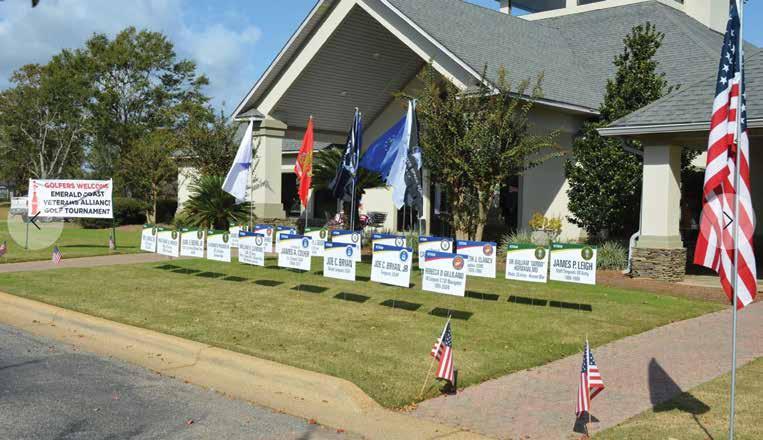
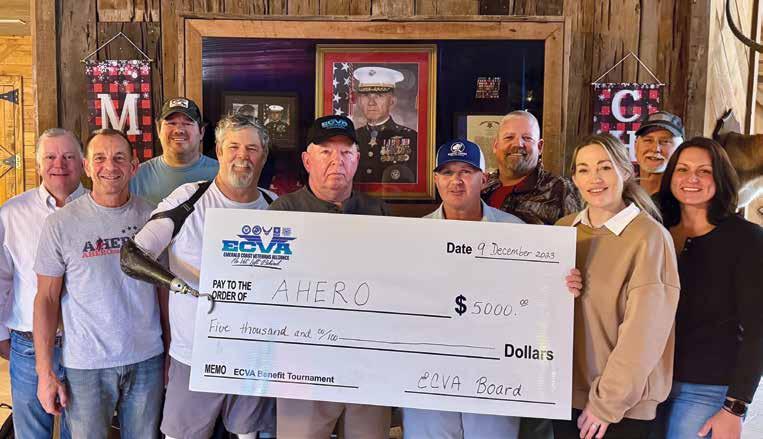
Although COVID set back its efforts to establish a Veterans treatment court (VTC) in Santa Rosa County, Florida, the committee tasked with accomplishing it has made real progress. Our goal of implementation by 2024 is now in sight.
A VTC addresses behavioral issues which may have contributed to a given Veteran’s initial arrest. PTSD or traumatic brain injuries are pre-existing conditions that may well have exacerbated behavior that prompted the arrest. In this scenario, the mental-health counselors available at the court are able to address them with the Veteran. It’s important to remember that it is not only the Veteran who is affected by a run-in with the law. The family frequently suffers as well, both emotionally and financially.
First and foremost was the funding shortfall. Florida’s 1st District courts must project out two years. This means that in order to stand up a VTC in Santa Rosa County, a two-year funding bridge must be in place.
This is where Florida State Senator Doug Broxson comes in. Approached at an evening function in Pensacola about the need for such a court in our county, he didn’t hesitate. “Get the paperwork to my staff on Monday morning,” he said, and we did. For us, optimism and hope were born that evening.
Tommy Nichols and his father jumped on board our working committee. Tommy orchestrated a video interview about the need. In the interview, I discussed the VTC concept, describing it as a diversionary problem-solving court at which VA mental-health counselors as well as prosecutors, public defenders, probation officers, and a court coordinator are overseen by a former member of the military. In this case, that would be Judge Tony Giraud.
Judge Giraud had wanted to run a VTC for years, but funding was always the issue. Some used the statistics to rebuff the need, citing that only 22 Veterans had attended in our sister-county’s VTC from 2019-2023. However,
with our ballooning population at 199,000 now and projected to grow to 270,000 or more by 2040, the number of Veterans will increase accordingly.
These fluctuating statistics were why we met with the Santa Rosa’s Sheriff’s Office (SRSO) to ensure that, shortly after an arrest, the person in custody is always identified as a Veteran if this is the case. Determination can then be made as to whether the details of their alleged crime suggests they should be eligible for VTC. We have shared the updated Okaloosa County’s VTC jail-intake form and have written a comprehensive definition of who exactly is considered a US Military Veteran.
Much progress has been made since our 2021 report in this magazine about establishing a Santa Rosa County VTC. Florida State House of Representatives’ Rep. Joel Rudman agreed to seek a companion House appropriation for a Santa Rosa County VTC. Also, Judge John Miller, chief judge for the 1st Judicial Circuit, has confirmed in writing his full support of this effort.
He recognizes our large military population – many who have been injured or traumatized by witnessing unspeakably horrific scenes that predisposed them to triggers, flashbacks, PTSD, and more.
However, as appropriations requests go forward, we need people like you to get involved. Our “wish list” now is for:
J Military Mentors who can meet weekly with the Veteran over a12-month period.
J Business owners able to offer part-time or full-time employment.
J Volunteers to help the VTC coordinator.
J Organizations willing to donate funds items such as service flags and refreshments.
J Letters of support to accompany the House and Senate appropriation requests. Address letters to the Florida Legislature and email them to:
Veteranstreatmentcourt4SRC@gmail.com
AHERO Magazine will continue to provide updates on Santa Rosa County’s planned Veterans Treatment Court as they come in.


Lt Col Carmen Reynolds, USAF (Ret.) speaks to members of the Legislative Delegation Oct. 24, 2023, explaining the need for a Veterans Treatment Court in Santa Rosa County. She highlights the collaborative stakeholders in full support of this initiative.
Meet Jason Crawford …
By Veteran Jason Crawford, Sergeant, Florida Army National GuardSomething that is deeply ingrained in the American psyche is that we so often seek to lift others up with the energy we draw from triumphing over our own adversity.
This is surely true of our American military members who rise to extend help and care to their fellow Veterans still struggling to recover from trauma and the devastation they have seen.
In his letter here, Veteran Jason Crawford details his fellow Wolfpack soldiers’ experience of being the first Florida National Guard Company from Pensacola to ever deploy to war. He quietly captures his pride in his Bravo Company Wolfpack members and how they have continued to develop their legacy by supporting, in a big way, the education of the next generation of UWF Florida National Guard members preparing to follow in their worthy footsteps. ~ the editors
For the first months in Baghdad, Iraq 2003, we were completely self-sufficient in the middle of an active war zone, receiving no support or supplies (including food or water) due to the natural chaos and “fog of war.”
Living exclusively “outside the wire” of bases or fortified locations, immersed among the general population, we identified and cleared buildings to live in, defend, and run 24hr combat ops out of. For us, along with the population of six million people, there was no running water or power. We had no contact with home (including letters) or the outside world for months.

For transportation, we confiscated Iraqi government vehicles, hot-wired them, and axed the doors off to use the cars as gun trucks. For many months, we didn't have plated body armor or armored vehicles for the job of hunting the most dangerous men in Iraq.
Despite our perceived limitations, we were very effective and successful in our mission of engaging or capturing the enemy.
Although located in one of the most hostile areas of Baghdad, we maintained the priority of keeping our surrounding neighborhoods, schools (once up and running), and hospitals
safe from extremist violence. During most of our tour, we were the only soldiers in Baghdad conducting foot patrols on the streets. Almost every other soldier in town rode in heavily armored track vehicles.
We kicked in countless doors on late-night raids throughout the city, conducted thousands of dismounted and unarmored mounted combat patrols, were targeted daily by gunfire and IED’s. Mortared multiple times, we were rocketed, suffering grenade attacks and an RPG ambush.
The 3/124th INF was the first reserve component unit in the Army to be awarded the Combat Infantryman Badge since the Korean War. Last year, we commemorated our 20-year anniversary of fighting in Iraq, 2003-2004.



THE “TICK-TOCK” OF DEPLOYMENT
December 2002: Recovering from Christmas festivities, the soldiers of Bravo Company (Wolfpack), 3rd Battalion, 124th Infantry Regiment of the Florida Army National Guard receive orders to report …
January 2003: Mobilization training then deployment to the Middle East. One hundred thirty-seven soldiers ready to endure the rigors of war in the first overseas deployment of Florida Guard since World War II …
April 2003: Bravo’s Wolfpack soldiers fly into Baghdad International Airport (BIAP), one of the first units, and link up with the rest of 3rd Battalion (Warrior) … Bravo immediately is moved to its area of operations, Zone 17, middle of Baghdad, to relieve two units of 101st Airborne …
Early May – late June 2003: Bravo successfully conducts split-unit operations in Zone 17. Despite shortages, with often dated equipment, lack of transportation and personnel compared to their active-duty counterparts, Wolfpack makes its presence known …
August 2003: Bravo is again relocated, consolidating with Headquarters and Alpha Company at Forward Operating Base Warrior (a former Republican Guard facility) …
November 2003: Specialist Robert Allen Wise (Alpha Company 3/124) is Killed in Action by IED blast during a patrol … painful reminder of the constant danger …
December 2003: while performing a multi-compound raid, Wolfpack suffers major injuries … Sgt Jason Crawford and SSgt Dustin Tuller wounded in action, both survive …
Late January 2004: Home after thousands of patrols, hundreds of checkpoints, countless raids and supporting operations. The men of the Wolfpack earn their Combat Infantryman Badge, a cherished honor … the Warrior Battalion (members) receive Presidential Unit Citation for Conspicuous Gallantry, Determination, and Esprit de Corps under extremely difficult and hazardous conditions ... THE REAL PRIZE:
Returning home with all members of Wolfpack alive.
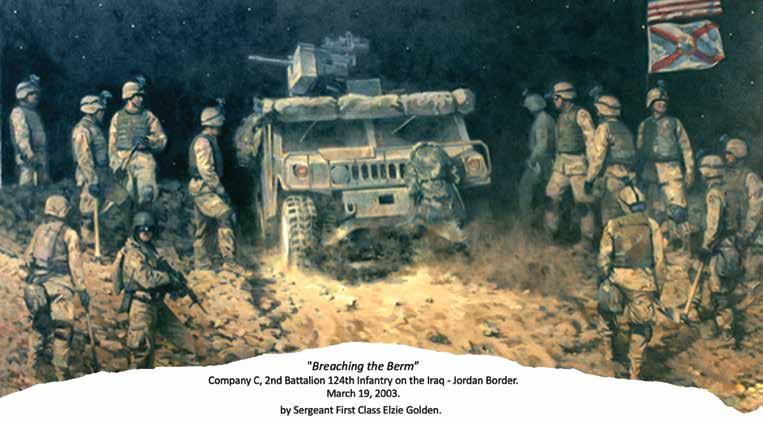


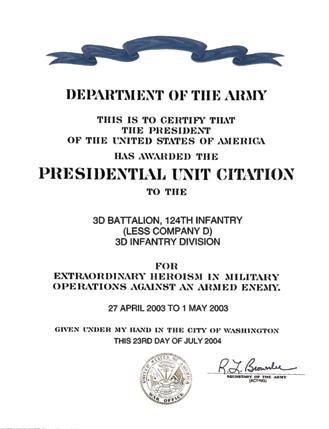
AHERO exists to serve wounded heroes. It is made possible because of the unseen, unsung heroes.
Each event AHERO runs through the year for the Veterans and First Responders must be backed by tens of thousands of dollars of contributions. These dollars are needed to cover transportation (air fares), accommodations (hotel rooms for 3 nights), food, activities, and myriad miscellaneous or unforeseen expenses.
And whether they come in actual dollars or in material contributions (such as accommodations donated by hotels, food/ dinners by restaurants, etc), this financial contingency must be met. Deep-sea fishing trips in the Gulf, in particular, can get very expensive – with AHERO needing to find approximately $2,000 for each participant. Often 50 of them show up. Do that math.
Consider AHERO’s Orange Beach Warrior Hook Up May 2022 event. The bill came to around $20,000 for hotel rooms alone. A “compromised” year due to Covid, it could have come to much more for that same event this year. Except it didn’t. Instead, the lodging bill for 2023 was $0.
Coast Guard Veteran Dave Riley starts that story. He introduced us to Mr. Tracy Trost, a man who is making waves in televisionproduction circles.
Riley called Dave Glassman and myself last summer (2022) and suggested we talk to this pretty well-known TV producer buddy of his, who is involved in helping Veterans. We arranged to meet him and Riley in a coffee shop in Orange Beach. We all immediately hit it off.



The vibe was good. So much so that, before we’d finished our java and our guest had to leave for an appointment, he announced that he wanted us to have use of his “rental house” on the beach for our Vets to use during the 2023 Orange Beach Warrior Hook-up weekend.
We thanked him but politely explained that we had “quite a few folks showing up.” That we really appreciated his concern and the spirit behind his offer. He nodded thoughtfully and was gone. The three of us sat down again, feeling warmed by this kind man who’d offered
up his rental, even though he could have no idea that by “quite a few folks,” we meant potentially 50!
Someone’s phone pinged. It was a text, with a link to the rental beach house. We saw it was not just close to the beach (as most are) … it was literally on the beach. Like, on the sand. With an uninterrupted view of the ocean.
And it was... huge. Three floors. Nine luxurious bedrooms. Would sleep 32 guests in serious comfort. Plus, a huge living area. Monster kitchen. And a pool!
But that was only half of it. Literally ...
half. Because that nine-bedroom house was mirrored by another nine-bedroom house. Also with a kitchen and pool. Also accommodating 32 guests. On top of that, they had an elevator and were ADA compliant. Perfect for some of our physically disabled veterans.
And both these houses were available for us to use!
These were accommodations that sell out on VRBO for $1500+ a night. But they were ours for housing qualifying AHERO Warrior HookUp participants – folks who had endured some


tough stuff serving the rest of us and surviving the seen and unseen trauma of doing so. This was a gift from his heart to them.
We counted our blessings, so grateful to this brilliant, humble, big-hearted new friend and supporter. A man who, though personally quite modest and understated, is a highly respected film and television maker (Trost
is also a producer of fundraising videos for many organizations, including, DAV (Disabled American Veterans), which is how Trost and Riley, a former president of DAV, originally met.
LESSON LEARNED
One of the things we’ve at times gotten mired down in at AHERO is trying to fit too
many activities into a single day. Gearing up, fishing, motivating, speechifying, singer/ songwriting partnering, musical interludes, etc. Always with much traveling to, between, and from locations.
This year, we decided on a new approach: Chill. Do less. Stay in one place. Enjoy the conversation, the blue-green waters, the sun.


Because this year, we were fully located on the beach. We were at home in a huge house (um, two huge houses) on the beach.
This time, all those activities could come to us.
Guest speakers, songwriters, singers – heck, even the restaurant came to us! And what all that meant was, our Vets and First Responders could spend serious time talking, communing, connecting, walking on the beach with new buddies, chilling by the pool – finessing your yoga poses, or maybe getting “downward dog" for the first time!
What was donated to AHERO for this year’s Orange Beach Warrior Hook-Up was that one commodity many of us have come to think of as precious: Time. Which really is a great healer.
Never take chance meetings lightly. They may be filled with the answer you have been looking for.



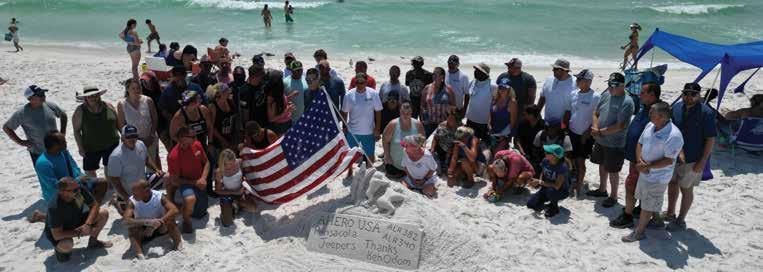

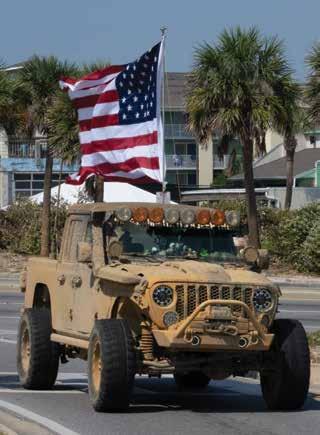

Our service peers and community. Those are the two elemental things those of us who have served miss most when we separate from the Armed Forces. And what I’ve discovered in my journey to “re-acclimate” after service is that I am no different.
As a Surface Warfare Officer (SWO) turned physical therapist, I was fortunate enough to receive training as a medical acupuncturist. Looking back, I know that’s when I discovered that I took real joy in caring for others with an “East meets West” approach to healing.
So, after the Navy, I continued my education to become a licensed acupuncturist. But I was also searching for the people and that community that I missed … Veterans, who, like me, had completed their service but still missed some aspect of having lived that experience.
What I found is, if we keep searching, sooner or later we find what it is we need –and really want to do.
When I heard about AHERO, I saw that it was about community and growing as an individual. The organization encourages exploring resources that can assist participants in that “growing.” And as I have a strong desire to be such a resource, I knew I could help.
Traditional Chinese Medicine (TCM) offers an alternative to prescription medicines. The main principle is to treat the individual as a whole. This differs somewhat from our modern approach of sub-specialties that only focus on one body system. Since one system affects the other and by understanding that each person is a product of their own unique experiences, a TCM practitioner is able to provide treatment respectful of that individuality.
Many people choose not to turn to TCM because they are unsure of what conditions it can address and effectively treat. Or maybe they barely know about it at all or have only heard about “the needles” and shy away without learning more.
The facts are these:
J Acupuncture is an ancient medical modality today practiced by highly trained individuals using the very latest, exceedingly thin, sterilized, single-use needles to stimulate points in various parts of the body.
J Each point addresses specific functions and purposes similar to those addressed by valves or switches in mechanical or electrical systems.
J These same points can also be stimulated without needles. This is called acupressure. Regular acupuncture and needleless acupressure together amount to only one facet of TCM. Chinese medical massage is called Tui Na and focuses on acupressure points and the smooth connections throughout the body. Another area of TCM considered a self-care technique that falls in line with today’s concept of physical therapy, is Qi Gong (pronounced ”Chi Gong”).
MY FIRST AHERO WARRIOR HOOK UP: AUGUST 2023, PENSACOLA BEACH
I was glad to be asked to attend AHERO’s signature Warrior Hook Up event to provide exposure and awareness of Traditional Chinese Medicine (TCM). I knew that countless service members had turned to medical professionals in search of healing only to walk away with prescription medications that seemed to simply mask the symptoms and could also create issues with side effects or worse, dependency.
During the event we introduced the concept of TCM with a “community acupuncture” session, which is a group setting with participants seated in a circle and sharing the experience in a free flow of conversation. There were 16 participants on our first night.
Some participants had never experienced acupuncture and just dreaded “those needles.” Especially when they might be placed in their
ears. Able to watch others being treated first, some decided against needles that first night and opted for ear seeds instead. What in the world, you may be wondering, are ear seeds?
Answer: They are small, gold beads, or sometimes vaccaria seeds, on a small circular Band-Aid. The consensus from everyone on the first night was a sense of relaxation and peacefulness.
The next few days offered the opportunity for individual treatments. In this more personal setting, patients relaxed in a room with mellow lighting and peaceful music on a treatment table with pillows for comfort. Patients were asked about their symptoms and their goals for treatment. During these treatments, a combination of scalp, body, and/ or ear acupuncture points was used.
Most participants found the treatments relaxing. Some dozed gently, while others sank deeper into soothing snores. Participants later commented on the peace that settled in allowing their thoughts to wander to places that had not been visited in a while.
According to Robert Queen, USN, “We felt very welcomed and very relaxed. There was no concern of pain or problems during the treatment.” Others said they somehow just felt better. Robert Woodin, USAF retired, reported feeling more relaxed and able to sleep better after his treatments.
Several of these patients have opened to the idea of an alternative approach to their health and taking more personal responsibility in maintaining wellness. David Mohammed, USA, retired from service with a background in medicine as a combat medic. That, coupled with his naturally inquisitive mind, made David a patient excited about all the new possibilities.
In addition to specific acupuncture techniques (using needles with or without electrical stimulation, seeds, or pressure), we completed a session of Qi Gong near the beach. The ocean breeze and sunshine were a perfect backdrop for this meditation-withmovement session.
The key here was to be open to trying new activities and trusting that you have so much healing power within yourself. Participants later commented that they enjoyed the movement and breathwork in this session. I learned that some had heard of the practice, but never had tried it themselves. This was a fantastic opportunity to try something new with the amazing support of fellow Veterans.
From my perspective, bringing reliable information and learning experiences to fellow service men and women in a safe, supportive environment was the best part of my first AHERO Warrior Hook-Up event!







Well before Kappa Sigma’s annual Golfing4AHERO tournament at the Perdido Bay Golf Club got underway on November 20th, two brothers of the Kappa Sigma Fraternity’s Sigma-Xi chapter stepped into new roles. For the first time in five years the previous head coordinator and alumni advisor of the event, Hunter Labbie, would not be overseeing the event.
Instead, last year’s coordinator, Mason Mallory, and I as the chapter’s fundraising chair and new head coordinator of the tournament, got the ball rolling. “It will take an enormous amount of planning and work to make our tee time in November,” Mallory said.
We were also, of course, focused on beating our previous record and setting a new standard.
Mallory, who is on the executive committee for the Kappa Sigma Fraternity, works 40-plus hours per week in construction and is a fulltime student at the University of West Florida. He relied on me and a few Kappa Sigma brothers to begin the process, keeping him informed.
The rigorous preparatory work started in March. This involved laying the groundwork and pursuing fundraising. By September, things started to get rocky and then we reached a slump. A number of sponsors and teams we had spoken to either backed out or stopped communicating.
Around 40 days out from tee-off, I started to worry. The situation was dire: We had only raised $12,000.
I decided to head back home to the Florida Keys for potential sponsorships, taking a route which led me through Jacksonville. There, I met Labbie in person. A Zoom meeting ensued with Mallory signing in. We devised a plan drawing on our previous annual tournaments, which gave me the support needed to flip things around.
Our goal was to have $18,000 raised before tee-off, just 30 days away. I returned to Pensacola and during our chapter meeting, we all agreed to step up our efforts to find new sponsors and team volunteers.
I spent much time that next week in Pensacola looking for sponsors. The rest of the guys were stepping up and slowly, by the grace of God, we started seeing sponsors as well as team volunteers “sign on” to support AHERO this way. This chapter truly showed me what brotherhood and passion could do for the heroes who protect and serve this country. In just one month, we had raised $6,000 and had reached our goal of $18,000!
Though truly in shock, I was nothing but grateful for every brother who helped and every person who had donated to AHERO and its great cause.
At the beginning and during every golf tournament, our fraternity sells mulligans and other various tickets, allowing golfers to improve their score by receiving some form of assisted shot. Another activity at the event is the raffling off of items such as jewelry and Yeti coolers, as well as selling AHERO merchandise to benefit the cause.
As I saw it, we could (with a miracle) possibly get a large, last-minute sponsorship right before the shotgun, and maybe another $1,000 from the ticket sales. Then I began to realize that we were drawing in more and more money. Near the end of the event, we were sitting on nearly $20,000.
Which was a miracle to me. Was there a possibility of beating last year's record? If we pushed for more ticket sales? But the tournament was coming to an end, so I knew I’d have to give it my all. I spoke to every golfing team as soon as they finished – would they like to purchase tickets for the raffle? I was making progress, but soon I could see it wasn’t enough.
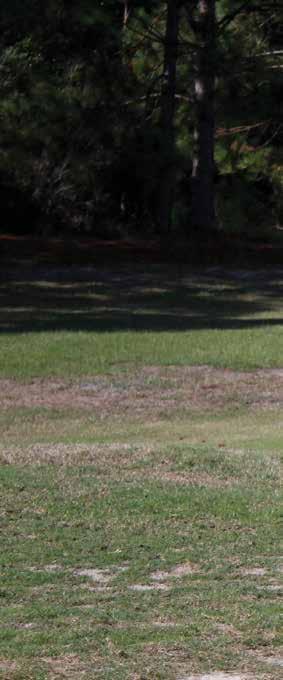




Now I truly lost all hope. But – funny thing: That’s just when another miracle happened. The Lacour family and a few other folks spoke with us and a little later, purchased a large sum of tickets as well as donating the remaining amount that was left to beat the record!
What was nothing short of a multitude of phenomenal events and actions would finalize the comeback that no one expected. It is inspiring what these great gentlemen have done and can accomplish. Through
many struggles, the members of the Kappa Sigma Fraternity’s Sigma-Xi chapter have always managed to excel while giving back to others and being great role models in their communities. I am personally so proud of these great men and excited for their futures.
As eternally grateful supporters of AHERO and the Veterans it seeks to help, our amazing members went through much to achieve this success. So, on behalf of them all, I want to thank the AHERO organization of volunteers
for all of their work in helping our Veterans. When it was all said and done, the full “take” was $21,637 … and for this success I know huge thanks go to Brothers Mason Mallory and Hunter Labbie for their huge help and constant encouragement.
We are extremely grateful to all active duty members and Veterans who serve and have served and protected this great nation that we are blessed to call our home.
Diving 4AHERO (D4A)’s official start this year as an outdoor activity feature of AHERO was highlighted at Dive Pros on October 18th. At the event, the Infidels motorcycle group presented a much-appreciated fundraising check to AHERO.
Infidel members never fail to support the Veterans AHERO helps, and Dave Glassman, VP and perennial AHERO volunteer, was delighted to accept their generous check in the amount of $1300. The funds it represents –raised during the organization’s annual “Poker Run” fundraising ride – are earmarked for development of D4A’s process of certifying wounded and injured U.S. Veterans and First Responders in SCUBA.
D4A has now become another arrow in the “4AHERO” quiver of therapeutic fun-plusteamwork activities bringing wounded and injured Veterans and First Responders together in the kind of comradery that heals.
By Connie ConwayOnce certified, D4A divers will participate in underwater programs and events hosted or sponsored by Escambia’s Department of Marine Resources and Brady Hale’s Ocean Strike Team. With their focus on Gulf waters ecosystem preservation and maintenance activities, divers will participate in reef deployments for data collection and management, as well as lionfish kill events, etc.
The Combat Veterans Motorcycle Association (CVMA) displays the encased original Oriskany Flag that brings awareness of, and signifies support for, the current and future Esca-Rosa reef programs. Now, the flag also demonstrates CVMA ongoing support for AHERO’s “D4A” development.
The CVMA members are Veterans of the wars we (most of us) heard about or watched live reports on – or were actively involved
in fighting at some point in the last 70 years. CVMA members consistently support their fellow Veterans because, like them, these men and women took it upon themselves to pledge to serve and protect America, and then followed through on that promise.
Back in 2016, Chris Williams, Army Veteran and owner of the Jolly Roger Dive, was inspired to dive down to the resting place of the USS Oriskany and retrieve its drifting American flag. He did so, and in the keeping of the CVMA organization, it was cleaned of its many clinging barnacles and set in a secure frame.
Now the original USS Oriskany flag, which is still being displayed, has inspired AHERO to schedule an annual deep dive by its D4A Veterans to replace the flag with a new one. In this way, a crisp Old Glory will always “fly” as a symbol of the gallant ship that served its nation so well.




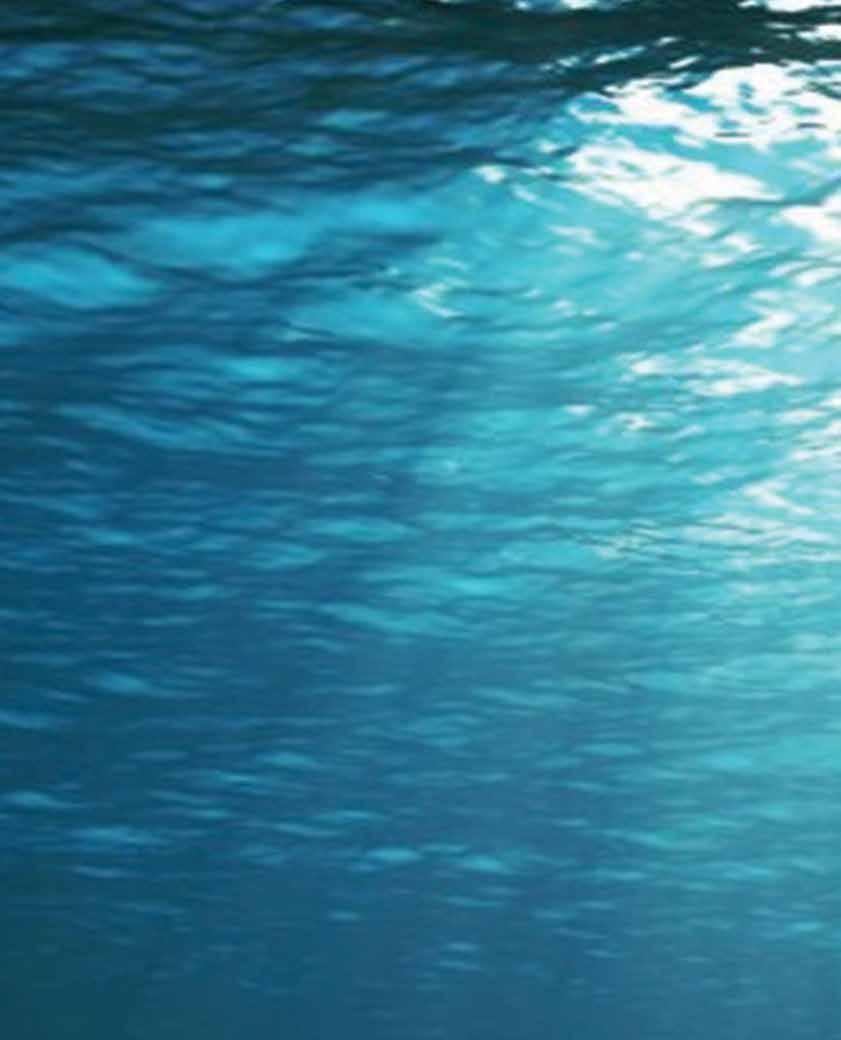

The USS Oriskany is the largest artificial reef in the world. The “Mighty O,” is an Essex class aircraft carrier that served in the Korean and Vietnam Wars before venturing to its final resting place, 22 miles off the coast of Pensacola, Florida. In 2006, the aircraft carrier, nicknamed “the Great Carrier Reef,” was purposely sunk in the Gulf of Mexica as part of an artificial reef pilot program. The 277 meter/911 foot-long vessel now draws marine life, underwater photographers, recreational and technical divers. The tower begins at 25 meter/80 feet, allowing recreational divers to explore the tower, officers’ quarters and bridge. With the wreck resting in 67 meters/220 feet of water, many areas below the flight deck can only be explored with advanced or technical diving certifications.

flag was flown on the mast of the USS Oriskany from Veterans Day 2016 until Fourth of July 2017 in honor of our military service men and women. Placed above the POW flag, it reminds us of the sacrifices these Veterans have made for ALL United States citizens. Commissioned in 1950 as the last Essex-class carrier completed, the USS Oriskany, or “Mighty O” to her crew, was decorated in both the Korean (2 Battle Stars) and Vietnam (10 Battle Stars) Wars. Overcoming a deadly shipboard fire in 1966, she served until decommissioning in 1976. In 2006, Mighty O’s final mission was to serve as the largest vessel sunk for an artificial reef. She is upright and accessible to recreational divers off the Florida’s Pensacola coast. Fourteen Veterans from Pensacola and Milton, Florida are responsible for the placement and preservation of Old Glory as a symbol of America’s freedom.
This
Diver investigates the Oriskany's American & POW Flags.


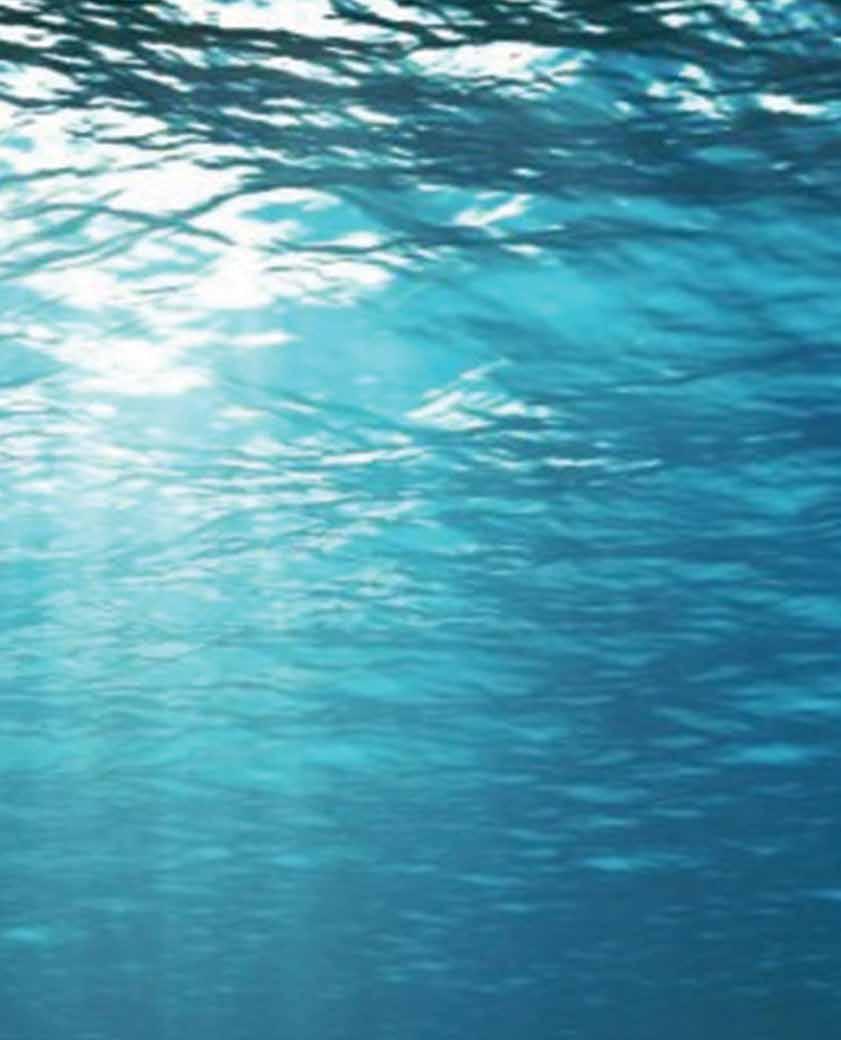
Divers on the Mighty O.
On October 22, 2023, the Pensacola Lionfish Shootout with Brady Hale presiding, was a two-day tournament attracting specialized and amateur divers from all over the country to help rid the seas of the unwelcome, predatory, invasive lionfish. The weekend event was hosted by Chief of the Beach, Mr. Robert Gleim, owner of the ever popular Bamboo Willies premium beach bar on Pensacola Beach.
Lionfish hunting generally involves dives as deep as 70 to 100 feet. Which is why only divers experienced and comfortable at such depths participated in the challenge.
Hunting for this particular quarry is not done with a huge spear. Instead, hunters use poles fitted with a steel pronged grip at the tip, and what looks like a big rubber band, like a Hawaiian sling (see the photo here with the lovely mermaid holding her lionfish spear).
True, it’s a modest-sized weapon. But Lionfish are not exactly big game … even though each one is constantly chowing down on the fish that actually DO belong in these waters!
You’re on the bottom, and shooting against a structure, say, a reef that can provide better contrast for visibility of the target. At your side is a container, a “Zookeeper” that can hold your catch instead of you having to clip the venomous spikes off each fish on the spot. The spike’s venomous sting won’t kill you, but it can make you dizzy, cause nausea, or produce convulsions – none of which you want to endure at 100 feet.
This year’s Shootout netted a total catch of 2488 – a lot of good eatin’ – plus it gave the Gulf’s native fish varieties a little more breathing room! Think of all the baby red snapper a lionfish can devour* at a rate of up to two per minute. Much better if they grow up and multiply, increasing the chances of snapper landing deliciously on YOUR plate instead!

*Scan the qr code to read the full, fascinating article, “The Worst Marine Invasion Ever,” by Christie Wilcox.
By Jeremy Clarke


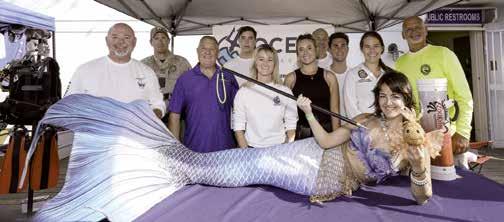
Since beginning in Texas in 2015 as the Lionfish Control Unit, Brady Hale’s non-profit Ocean Strike Team (OST) organization has been deeply committed to controlling the lionfish population in the Gulf of Mexico and other areas in which this invasive species has established “roots” – or in this case, has laid eggs.
OST expanded into Pensacola in 2021, where it continues to “lead the fight, expanding the concept of local control of the lionfish population by getting local divers into the water to clean the reefs of them,” Hale said. “We are aware that eradication is not possible, but we work towards removing as many as we can to give the native fish a chance to survive and thrive.”
Now a driving force throughout the Gulf of Mexico and the Caribbean, OST is engaging more and more divers to be actively involved in this important mission. “Instead of ‘boots on the ground,’ it’s ‘fins in the ocean,’” said Hale, “and the stakes are high for the Gulf waters.”
The seasoned diver described another priority of the group: research and education: “In order to affect real change, you need real facts. We continuously collect data and provide lionfish samples to organizations for additional research.” He explained that with the expansion
of other underwater opportunities such as shark-research diving, seagrass and scallop restoration, water-quality and reef monitoring, and marine and beach debris cleanups, the organization is expanding interest and participation in ocean conservation.
“We are living up to our name and mission: Anywhere the ocean needs our help, we send in a Strike Team of volunteers and divers to help,” he said.
In addition to stressing the need for public awareness of the lionfish problem, OST is a relentless advocate for maintaining sustainable and healthy sea life in our waters. Its members are armed with accurate information, including about the danger of the lionfish species expanding its numbers. Generating awareness of such issues can help bring pressure for adopting practices that benefit the Gulf of Mexico as well as other bodies of water.
During a typical lionfish hunting tournament weekend, new hunters begin with a class that includes the history of the lionfish: how it came to be in our regional waters, how it is a voracious eater with no natural predators and thus is quite literally leaving destruction in its wake. This is followed by extensive training on how to safely use the pole spear, which is standard lionfish hunting equipment.
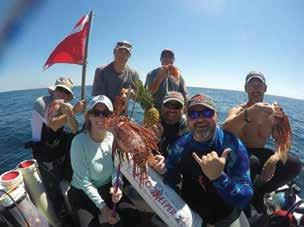

“Lionfish hunting is so much fun and so addicting because it is easy. It’s almost like the whack-a-mole game,” said Hale. “It’s not hard. It doesn’t take a lot of skill – you can get in there and shoot a lot of lionfish in a short amount of time without having to go through months of training.”
Hunters recently competed for nearly $125,000 in prize money at the world’s largest lionfish tournament in Destin, Florida. Astonishingly, the Emerald Coast Open (ECO) removed a record-breaking 24,699 lionfish from the Gulf! And this year, the Ocean Strike Team will be at the Emerald Coast Lionfish Open in Destin, Florida, May 17-19, and hosting the Pensacola Lionfish Shootout, Sept. 20-22, at the Pensacola Beach Boardwalk.
Divers and ocean lovers can become members by visiting OceanStrikeTeam.org. For a $35/year membership, you can participate in ocean conservation activities and help save our beautiful oceans and Gulf. Certified divers can attend the OST Lionfish Eco-trips.
Come get involved in Diving4AHERO (D4A)! Train alongside Brady Hale’s OST team and remove lionfish! Oceanstriketeam.org/lionfisheco-tourism-trips
Regular AHERO Magazine readers are familiar with the unceasing work carried out by the relentless Escambia County Marine Resources Manager Robert Turpin. No surprise here that now he’s building more reefs. Lots of them.
At present, he has some Turpin-sized grand plans and the partnerships to bring them to reality. Once entirely in place, the resulting massive regional artificial reef system will add to the existing $200 million dollars in annual economic benefit to this region and increase local job opportunities.
Ultimately, the new reefs will be of varying sizes that, once deployed, will stretch for many miles along the Gulf waters along Escambia and Santa Rosa counties’ coastlines, hence the name “Esca-Rosa”. Planning and design of the proposed new artificial reef sites is a team-effort between Escambia and Santa Rosa counties’ staff, Florida Sea Grant and Florida Fish and Wildlife Conservation (FWCC).
The Esca-Rosa Regional Artificial Reefs program was initiated earlier this year with the deployment of the Esca-Rosa Reef #1 and Esca-Rosa Reef #2 with Federal Aid in Sportfish Restoration funding through a grant from FWCC. The next step is to increase the number and size of artificial reef permits issued by Florida Department of Environmental Protection and US Army Corps of Engineers.
The new and expanded permitted artificial reef sites will add to the existing permitted sites Escambia and Santa Rosa counties already have at various locations in the Gulf of Mexico, Pensacola Bay and Santa Rosa Sound. The diversity of reef site locations, sizes, and water depths provide benefits to various stakeholder groups as well as the marine life inhabiting the reefs.
The area of greatest opportunities for new reefs is just beyond one mile offshore of the barrier islands. The waters and seafloor of
the Gulf of Mexico within one mile of the barrier islands is designated critical habitat for endangered Gulf sturgeon, so the proposed new reef sites will avoid that area. There are additional benefits to avoiding the sturgeon critical habitat: greater potential for abundance of snapper, grouper, triggerfish, amberjack as well as pelagic species including tuna and wahoo.
Both counties already have existing permitted artificial reef sites just outside the sturgeon critical habitat. These artificial reef sites are highly attractive and amenable for access by kayaks. The number of paddlecraft has steadily grown, in part due to the increased number of artificial reefs in accessible waters.
The genius is in the carefully thought-out designing of each component reef to attract and protect specific marine wildlife. By using prefabricated concrete artificial reef modules, the reefs can be sized and spaced according to specific design parameters.

Many contain an “eco reef” module inside the larger reef modules in order to increase habitat complexity. After reefs are deployed, it is important to monitor and evaluate cost effectiveness in terms of fish abundance and diversity as well as the level of satisfaction of anglers and divers.
Most inspiring, though, is the planned series of reverential Florida Underwater Military Appreciation Reefs, which can provide private space set aside for memorializing those wishing to have the ocean floor be their final tour of duty.
Escambia, Santa Rosa and other counties’ reef plans incorporate numerous individual projects, at various stages of development, and yield a vast underwater playground, collaborative research and monitoring opportunities, and an enhanced environment attracting a multitude of underwater species.
Altogether the amazing Esca-Rosa Regional Artificial Reefs project promises to enhance the richness and health of our Gulf waters and the quality of life of all who enjoy their beauty and boundless gifts.
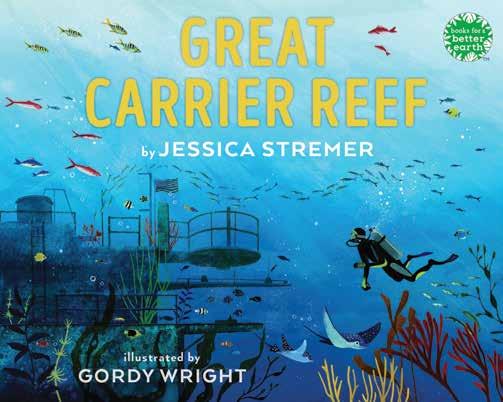
“The Great Carrier Reef” … a book by Jessica Stremer Young (and old) readers who love how the great works of science, technology, engineering and math (STEM) have shaped our world will be fascinated by the story of the “Mighty O” and how it came to rest on the sandy floor, 200-plus feet below the Gulf of Mexico waves.
Author Jessica Stremer had input from Escambia County’s own water-resource manager, Robert Turpin, in writing this vivid book, which was illustrated by Gordy Wright.
The book tells the amazing story of a storied American aircraft carrier that saw embattled duty in two wars then went on to endure a huge “nuts and bolts” transformation before being sent down 200-plus feet of the sea to serve as a vast reef able to bolster and enhance the health and variety of the Gulf’s living organisms.

